目次
- From the End of World War II to the Tokyo Olympics
- COMME CA DU MODE: 'Hard to Grasp, a Bit Disappointing'
- Feature: "Clothing with a Vintage Feel"
- The legendary "Black Shock" distressed knit.
- Back then, the value of "vintage feel" was considered more innovative than simply the color "black."
- Predecessor of Felting? Comme des Garçons' Processing Methods
- Clothing with a used aesthetic already carries a sense of attachment from the beginning for the wearer.
- Outro: "Japan as Number One" and "Japanese Designers as Number One"
From the End of World War II to the Tokyo Olympics
What I'm introducing this time is the September 10th, 1982 issue of "anan" magazine.
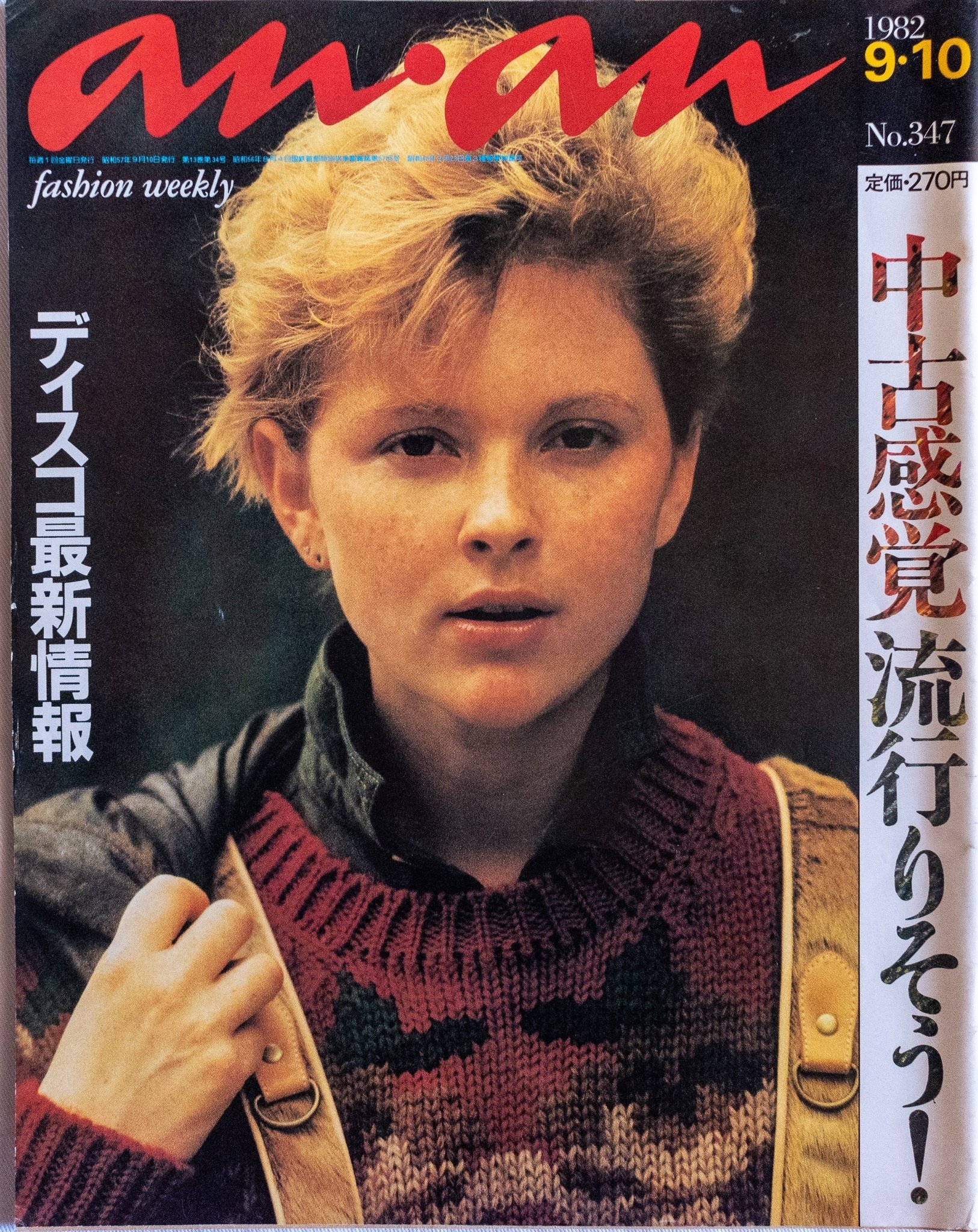
Before introducing the contents of the magazine, let's take a brief overview of the political and economic situation from the end of World War II in 1945 to 1982.
The post-war reconstruction, which began amidst the scorched earth, gained momentum with the outbreak of the Korean War in 1950. The Korean War prompted domestic companies to initiate active capital investment, leading to a situation where investment in one industry expanded through inter-industry linkages, creating a cascading effect of "investment calling for more investment."
The San Francisco Peace Treaty was signed in 1951, and the occupation by GHQ ended the following year in 1952. From late 1954, full-fledged economic growth began, and the Economic White Paper of 1956 declared that it was "no longer the post-war period."
In politics, the establishment of the "55-year system" saw the Liberal Democratic Party as the ruling party and the Socialist Party as the primary opposition, solidifying the foundation of post-war Japan politically and economically.
From 1955 to 1973, Japan experienced a period of high economic growth, with a real GDP growth rate averaging over 9.2% annually. During this period, Japan surpassed advanced countries one by one in terms of GNP size, and in 1968, it leaped to become the world's third-largest economic power, following the United States and the Soviet Union.
The influx of young people from rural to urban areas supported Japan's high growth. As the high growth began, industries in the Pacific Belt area, centered around the three major metropolitan areas of the Tokyo metropolitan area, the Kansai metropolitan area, and the Nagoya metropolitan area, developed.
During this period, not only production technology but also management techniques such as cost control, operations, and business management were introduced from overseas, mainly the United States, leading to a significant increase in productivity. As a result, wages also rose, and there was a continued migration of young people from rural to urban areas.
The Ikeda Cabinet, inaugurated in 1960, launched the "National Income Doubling Plan" as its flagship policy. As the name suggests, it aimed to double income, which may seem unimaginable now, but between 1960 and 1966, per capita income doubled.
The greatest milestone of the 1960s was the Tokyo Olympics held in 1964.
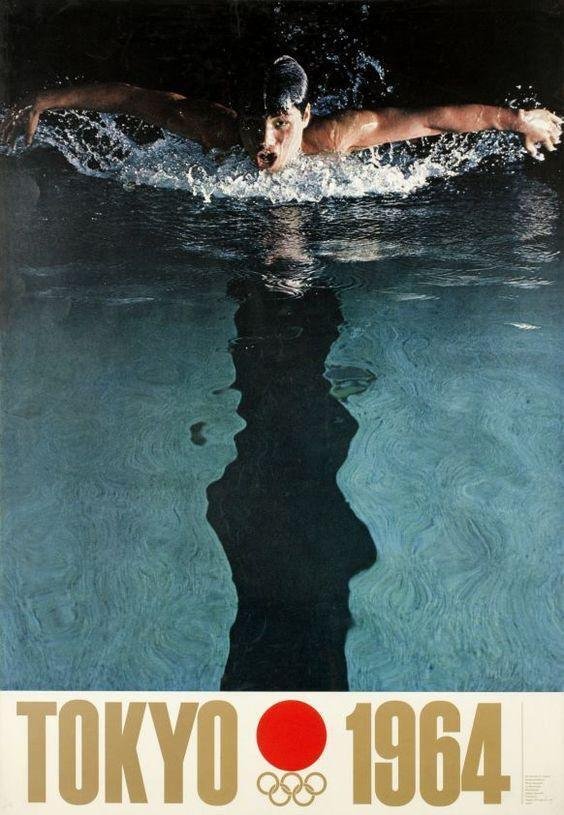 https://www.pinterest.jp/pin/14284923795778485/
https://www.pinterest.jp/pin/14284923795778485/
During this period, many transportation networks in Japan were either inaugurated or began their development. In 1963, the completion of the Tokyo Metropolitan Expressway, commonly known as the Shuto Expressway, marked a significant milestone. Additionally, in preparation for the Olympics, efforts were made to connect airports and accommodation facilities and to extend the subway lines and develop monorails to link scattered stadiums.
Furthermore, in 1964, the Tokaido Shinkansen, connecting Tokyo and Shin-Osaka stations, commenced operations.
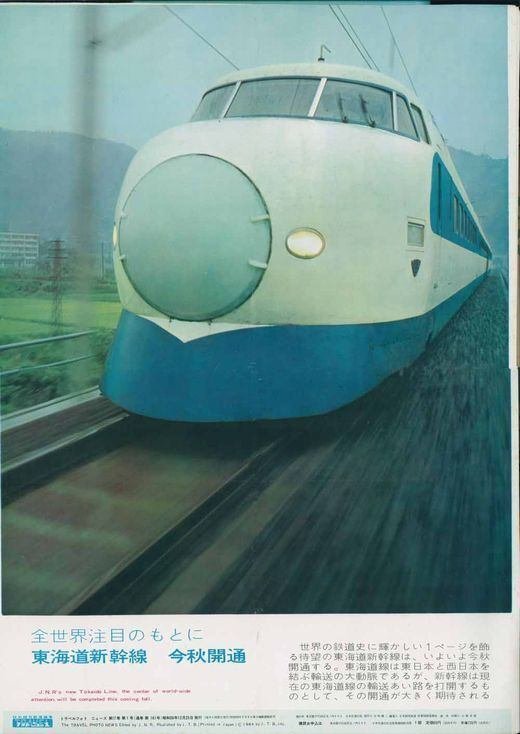 https://www.pinterest.jp/pin/5770305757192393/
https://www.pinterest.jp/pin/5770305757192393/
With the rise in income, personal consumption expenditure also expanded, leading to the arrival of the "mass consumption society." At its core were the "new three sacred treasures (3C)" of color televisions, automobiles(car), and air conditioners(cooler).
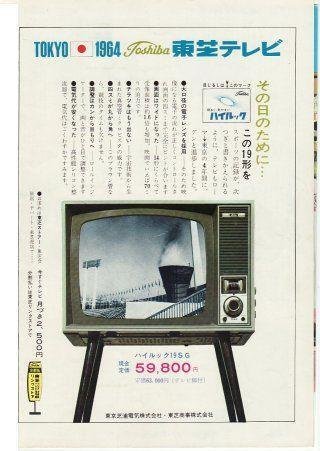 https://www.pinterest.jp/pin/360639882662332073/
https://www.pinterest.jp/pin/360639882662332073/
The emergence of new household appliances led to significant changes in the lifestyles of urban residents, eventually spreading to rural areas as well. The number of full-time housewives, which was 5.17 million in 1955, increased to 12.13 million by 1970, accompanied by a rise in non-regular employment such as part-time and temporary work.
Supermarkets such as Daiei, Yokado (formerly Ito-Yokado), and Seibu Store (now Seiyu) began nationwide expansion in earnest in the mid-1960s, selling groceries and daily necessities mainly through self-service systems. By 1972, Daiei had surpassed Mitsukoshi department store to become the top retailer in Japan, and by the mid-1970s, supermarkets had overtaken department stores in terms of retail sales share.
The Nixon Shock and Oil Shock
In the 1970s, Japan was hit by the Nixon Shock in 1971 and the Oil Shock in the same year.
The Nixon Shock, announced by President Nixon in 1971, was driven by the prolonged burden of the Vietnam War and the struggles of the United States with domestic finances and international deficits. Nixon declared the suspension of the convertibility of the US dollar into gold, which was fixed at 360 yen per dollar, leading to the breakdown of the fixed exchange rate system. As a result, the exchange rate of the dollar against the yen was revised to 308 yen per dollar the following year, and in 1973, the system transitioned to a floating exchange rate regime, which continues to this day.
In the same year, 1973, the first oil crisis, known as the Oil Shock, occurred. The establishment of the state of Israel in Palestine, declared by the Jewish National Council in 1948, was rejected by the Arab inhabitants of Palestine and Arab countries, leading to the outbreak of the First Arab-Israeli War. Subsequently, the Second (1956-57) and Third (1967) Arab-Israeli Wars occurred, leading to the Fourth Arab-Israeli War in 1973.
The Organization of the Petroleum Exporting Countries (OPEC), composed of Arab oil-producing countries, activated their oil strategy, which included cutting oil production, imposing embargoes on countries supporting Israel, and significantly raising oil prices from around $2 per barrel to around $11 per barrel.
Japan's manufacturing industry had been transitioning its primary fuel source from coal to oil, which was cheap and stable, during the 1950s and 1960s. At that time, Japan's dependence on oil imports was virtually 100%. Due to the Oil Shock, Japan experienced a sharp increase in prices, with consumer prices rising by 23% in 1974, leading to what was termed "hyperinflation."
Following the Nixon Shock in 1971 and the Oil Shock in 1973, Japan's economy entered a period of stable growth.
"Japan as Number One"
After World War II, Japan had been continuously growing, following the business model set by the United States and other Western advanced countries. This model reached its completion in the 1980s.
In 1980, the average exchange rate between the US dollar and the Japanese yen was 226 yen. Benefiting from this yen depreciation and dollar appreciation, Japanese manufacturers expanded their exports to the American market, leading to escalated trade tensions between Japan and the United States.
Particularly in the automobile industry, Japanese production surpassed 10 million units in 1980, surpassing the approximately 8 million units long held by the United States as the world's top producer and becoming the world's largest. American automobile companies, losing market share to Japanese cars, fell into financial difficulties across the board, leading to layoffs in the industry, resulting in over 300,000 unemployed workers.
In automobile dealerships in Michigan, USA, a service called "bash-for-cash" was offered, where people were allowed to vent their frustration by physically damaging Japanese cars. Scenes of hammers being swung down on Japanese cars became symbolic of the US-Japan trade tensions.
 https://www.pinterest.jp/pin/646336984018346906/
https://www.pinterest.jp/pin/646336984018346906/
In 1979, American sociologist Ezra Vogel published the book "Japan as Number One," which analyzed the reasons behind Japan's economic growth after World War II.
The previous year in 1981 (Showa 56), at the end of the Economic White Paper, there was a proud statement like this.
The Japanese economy has joined the ranks of advanced countries. A quarter-century ago (in Showa 30), the United States accounted for about one-third of the world's total production, ranking first, while the second-place United Kingdom had a mere 5%, and Japan had only 2%. Now (in Showa 54), the share of the United States has dropped to about one-fifth, and Japan has reached a share of 10% of the world's total production.
It can be said that Japan at that time had the confidence of being "Number One" economically, possessing the momentum to stand shoulder to shoulder with and even surpass the advanced countries of the West.
The Beginning of Harajuku Fashion
Now, let's delve into a topic closer to the heart of fashion.
As a result of the 1964 Tokyo Olympics, Harajuku underwent a transformation from a quiet residential area to a hub for young people with new sensibilities. Notably, at the intersection where Omotesando and Meiji Street meet stood Harajuku Central Apartment. Here, photographers, copywriters, illustrators, and other creatives set up their offices and studios. On the first floor of this building was a café called Leon, where young creators gathered, laying the foundation for a new youth culture.
Among those who set up shop on the ground floor of Harajuku Central Apartment was Milk, a brand that continues to represent Harajuku fashion to this day. At the time, there were only three boutiques in Harajuku, including Milk. It was truly a pioneering brand in Harajuku fashion.
In addition to Milk, other notable brands set up shops in Harajuku, Omotesando, and Aoyama. These include Mademoiselle NON NON by Taro Aramaki, BIGI by Takeo Kikuchi and Kae Inaba, Junko Koshino, and Nicole by Mitsuhiko Matsuda.
Japanese Designers Expanding Globally
After graduating from the Bunka Fashion College, Kenzo Takada moved to France in 1965. In 1970, he opened his first store, Jungle Jap, in Paris and debuted his collection. That same year, he received high praise, including being featured on the cover of the prestigious French fashion magazine ELLE.
 https://www.pinterest.jp/pin/501658845986995847/
https://www.pinterest.jp/pin/501658845986995847/
In addition, in 1971, Issey Miyake presented a fashion show in New York. His collection "Tattoo," featuring prints resembling tattoos as a tribute to the recently deceased Jimi Hendrix and Janis Joplin from the previous year, garnered attention.

https://www.pinterest.jp/pin/91620173655377634/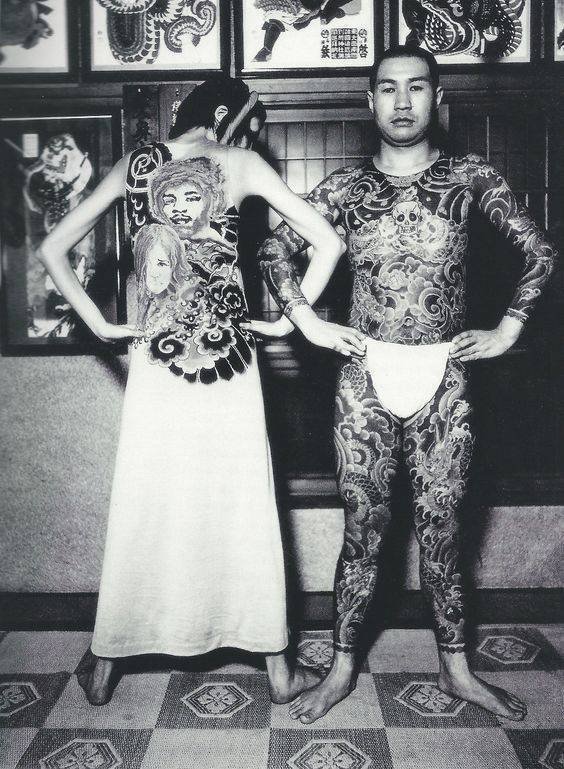 https://www.pinterest.jp/pin/94997873380208136/
https://www.pinterest.jp/pin/94997873380208136/
While working as a seamstress at Junichi Koshino's atelier, Yamamoto Hiroshi, who self-taught sewing, became the first Japanese to hold a fashion show in London in 1971.
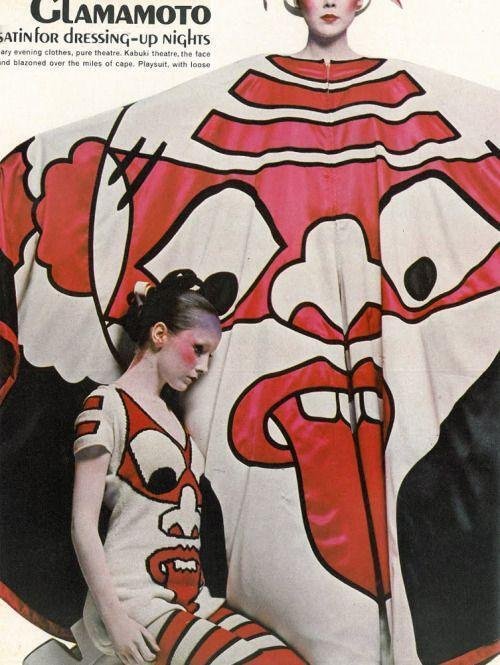 https://www.pinterest.jp/pin/177047829090564120/
https://www.pinterest.jp/pin/177047829090564120/
The show in London served as a catalyst, and Yamamoto Hiroshi received a request to create stage costumes for David Bowie's tour.
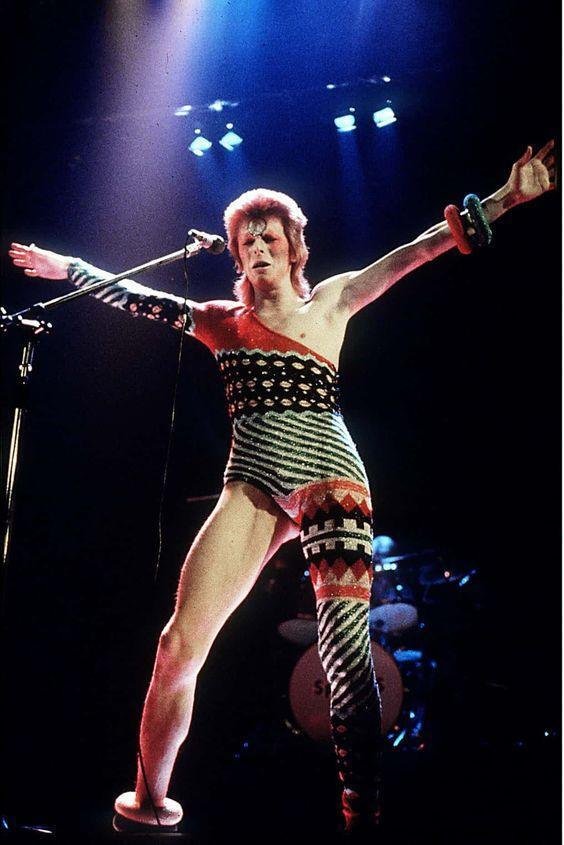 https://www.pinterest.jp/pin/AfPfNFwNalmNY3MjVws7Jz6hv93vIKuPzk5nhlqYhOvaRQlJQPRl_t0
https://www.pinterest.jp/pin/AfPfNFwNalmNY3MjVws7Jz6hv93vIKuPzk5nhlqYhOvaRQlJQPRl_t0
Fashion Trends Standard in the Early 1980s
"Designers like Yamamoto Hiroshi, who drew inspiration from traditional Japanese arts such as Kabuki, left a particularly strong impression. However, the works of Japanese designers such as Kenzo Takada, Issey Miyake, and even Mori Hanae, who ventured overseas in the 1960s, were characterized by vibrant colors and Oriental patterns, evoking a strong sense of 'Wa' or Japanese harmony.
Here is an example of the 1980 Spring/Summer collection by popular French designer Claude Montana."
 https://www.pinterest.jp/pin/672725263104487237/<
https://www.pinterest.jp/pin/672725263104487237/<
At that time, Western designers were known for presenting collections characterized by exaggerated shoulders, narrow waists, and vibrant color palettes. This type of fashion was the standard during that era.
COMME CA DU MODE: 'Hard to Grasp, a Bit Disappointing'
Let's once again introduce the September 10, 1982 issue of 'anan' magazine.

Above the table of contents, there's a rather provocative photo.

The lead feature is 'The Latest in Disco.' Interestingly, if you look closely at this page, you'll find a certain individual who had a significant influence on the global fashion scene. But that story will have to wait for another opportunity.
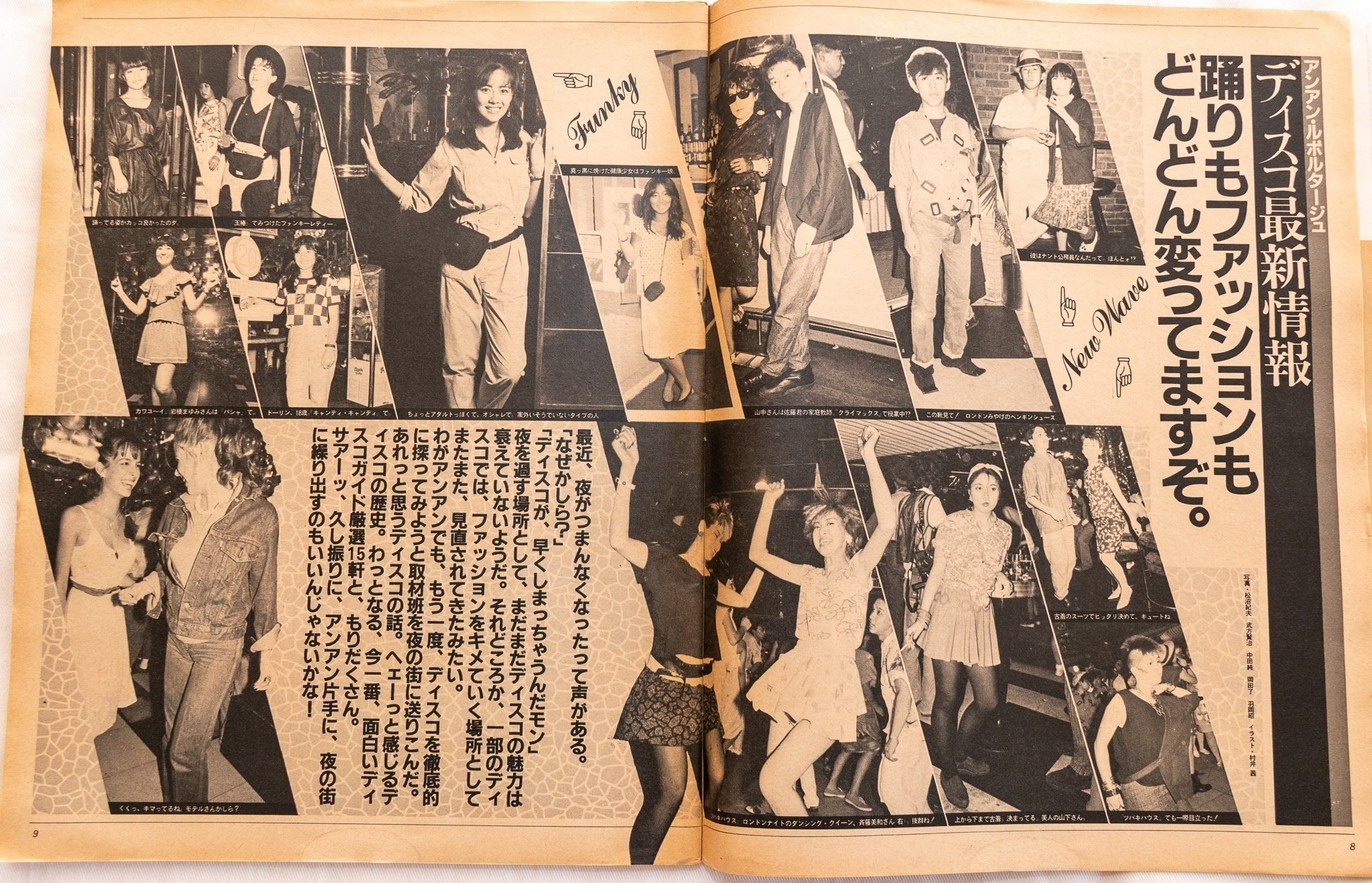
The 'Petit anan' section, which is like a news page.

"The highlight is on 'COMME CA DU MODE' holding its first fashion show after six years. Surprisingly, there's a rather harsh comment from a stakeholder: 'Hard to grasp, a bit disappointing. Fashion shows are boring without strong personalities. Some clothes felt like something we've seen before.' It's surprising to see such candid opinions published. You wouldn't find such content in today's fashion magazines. It's clear that back then, fashion magazines were still providing thorough critiques."
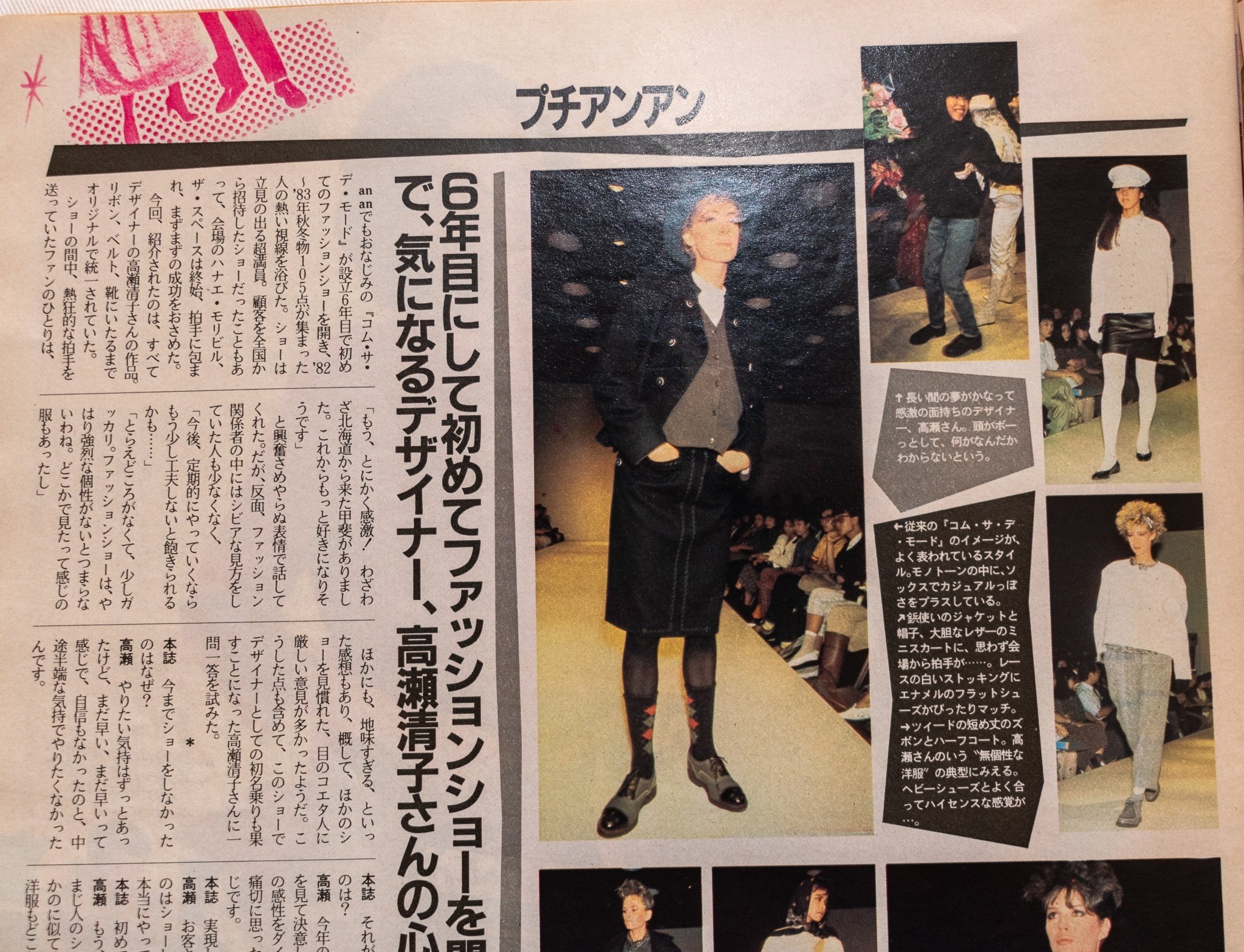
"The designer of COMME CA DU MODE at that time was Kiyoko Takahashi."
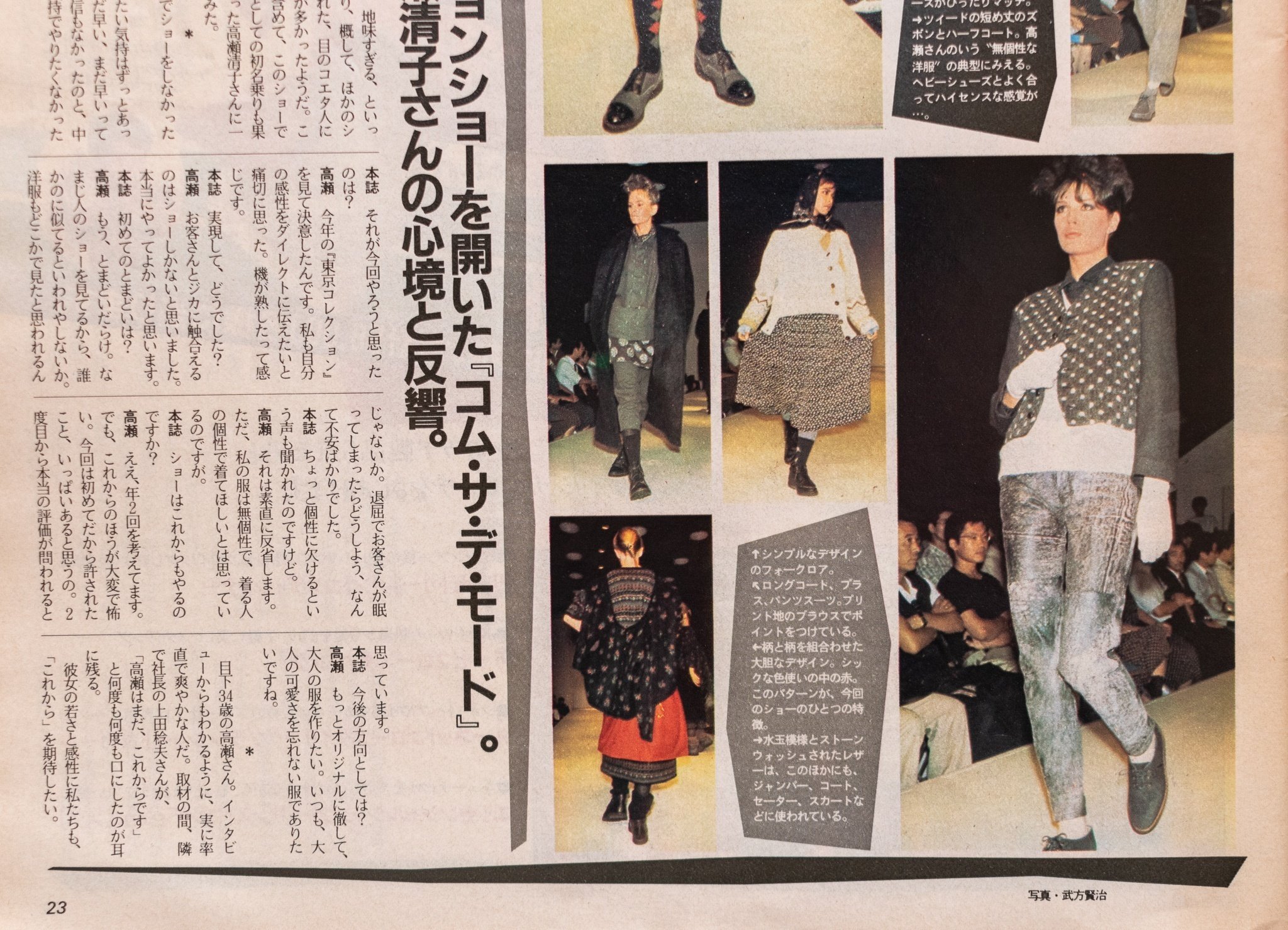
コムサ・デ・モードの創立メンバーで、現在は株式会社ファイブフォックスの取締役副社長を務められているようです。
 https://www.ucf.jp/graduate_voice/takase_kiyoko/
https://www.ucf.jp/graduate_voice/takase_kiyoko/

https://www.ucf.jp/graduate_voice/takase_kiyoko/
Feature: "Clothing with a Vintage Feel"
Here begins the feature on 'Clothing with a Vintage Feel.'
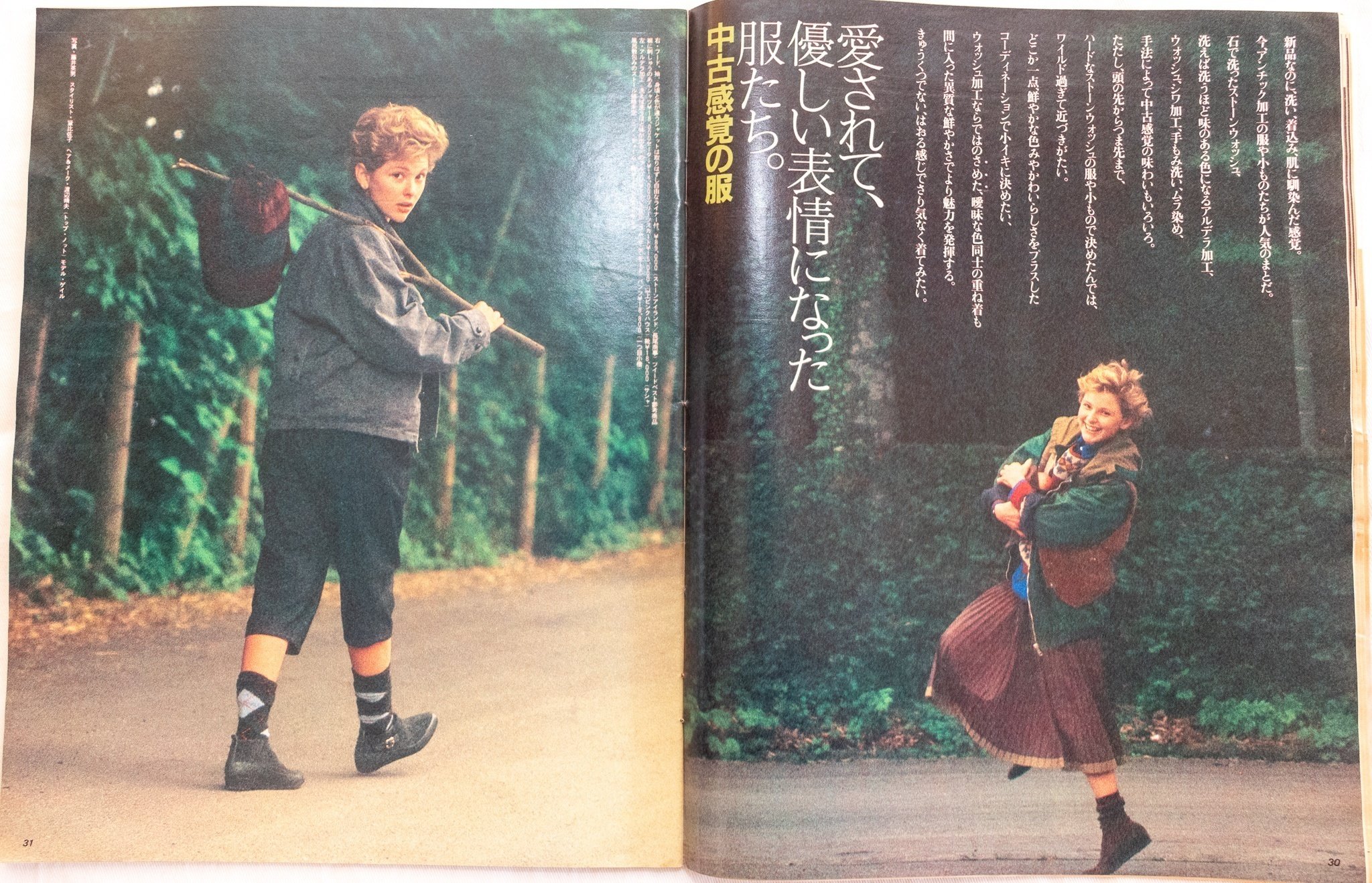
What is clothing with a vintage feel?
Despite being new, they give the sensation of being washed, worn, and fitting comfortably against the skin. Currently, antique-processed clothing and accessories are popular. Techniques such as stone washing for a worn-in look, aldera processing for a unique color that develops with each wash, washing, wrinkle processing, hand washing, uneven dyeing, among others, create various vintage sensations.
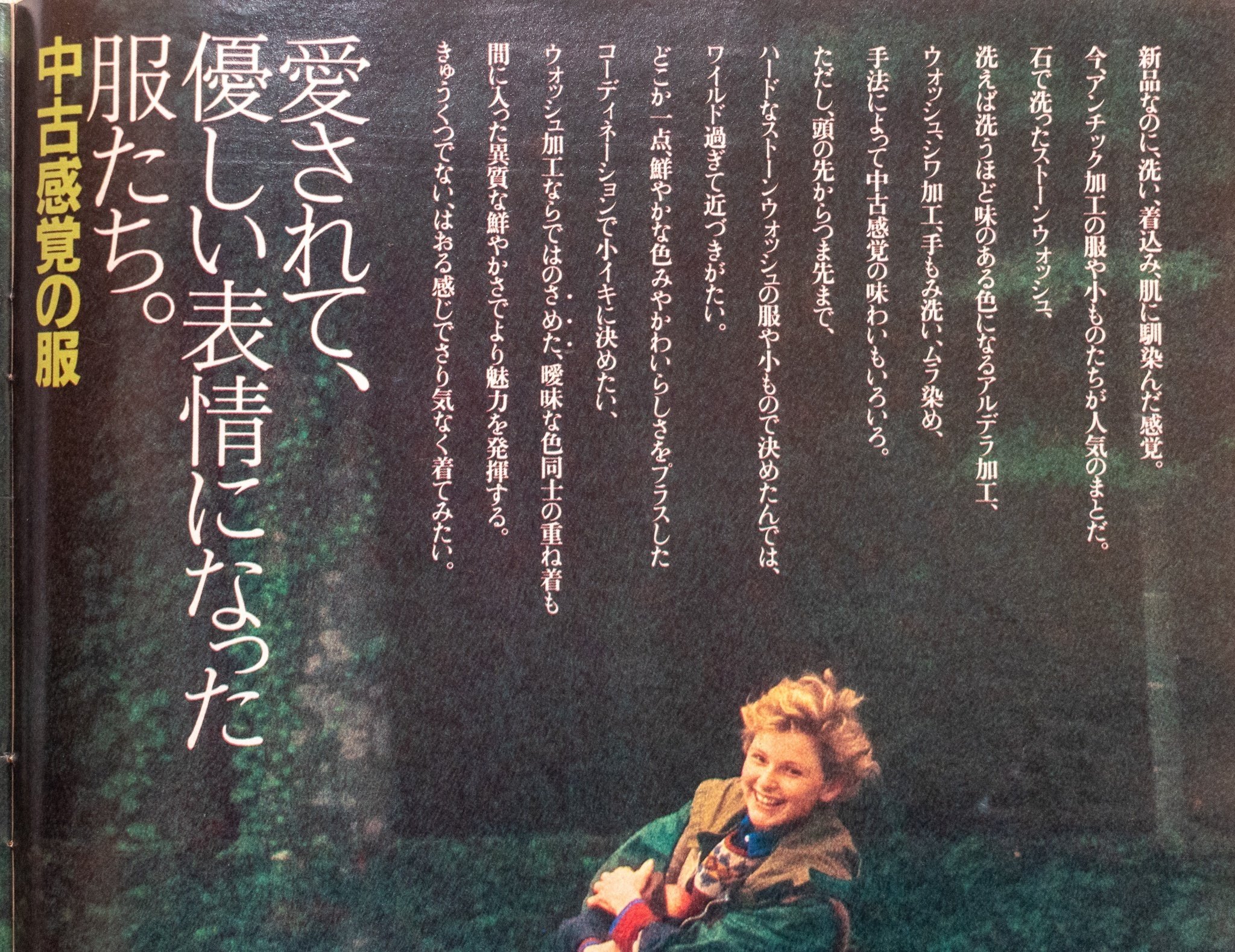
"So, first up in this styling, the vest, shirt, and pleated skirt are from PINK HOUSE."

"PINK HOUSE" is a brand founded by Tsutomu Kaneko, who was a classmate at Bunka Fashion College with Kenzo Takada, Mitsuhiro Matsuda, and Junichi Koshino. Known for its distinctive style packed with frills, lace, ribbons, and floral patterns, Pink House continues to be supported by many fans even today.
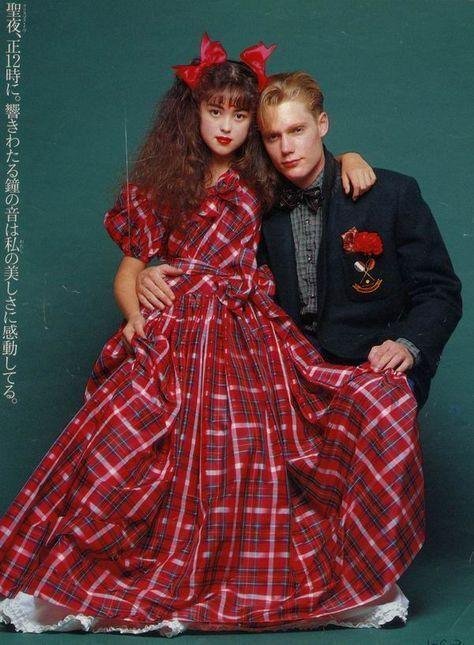 https://www.pinterest.jp/pin/1071575305062768560/
https://www.pinterest.jp/pin/1071575305062768560/
The left page features a boyish styling. The bomber jacket is from COMME CA DU MODE.
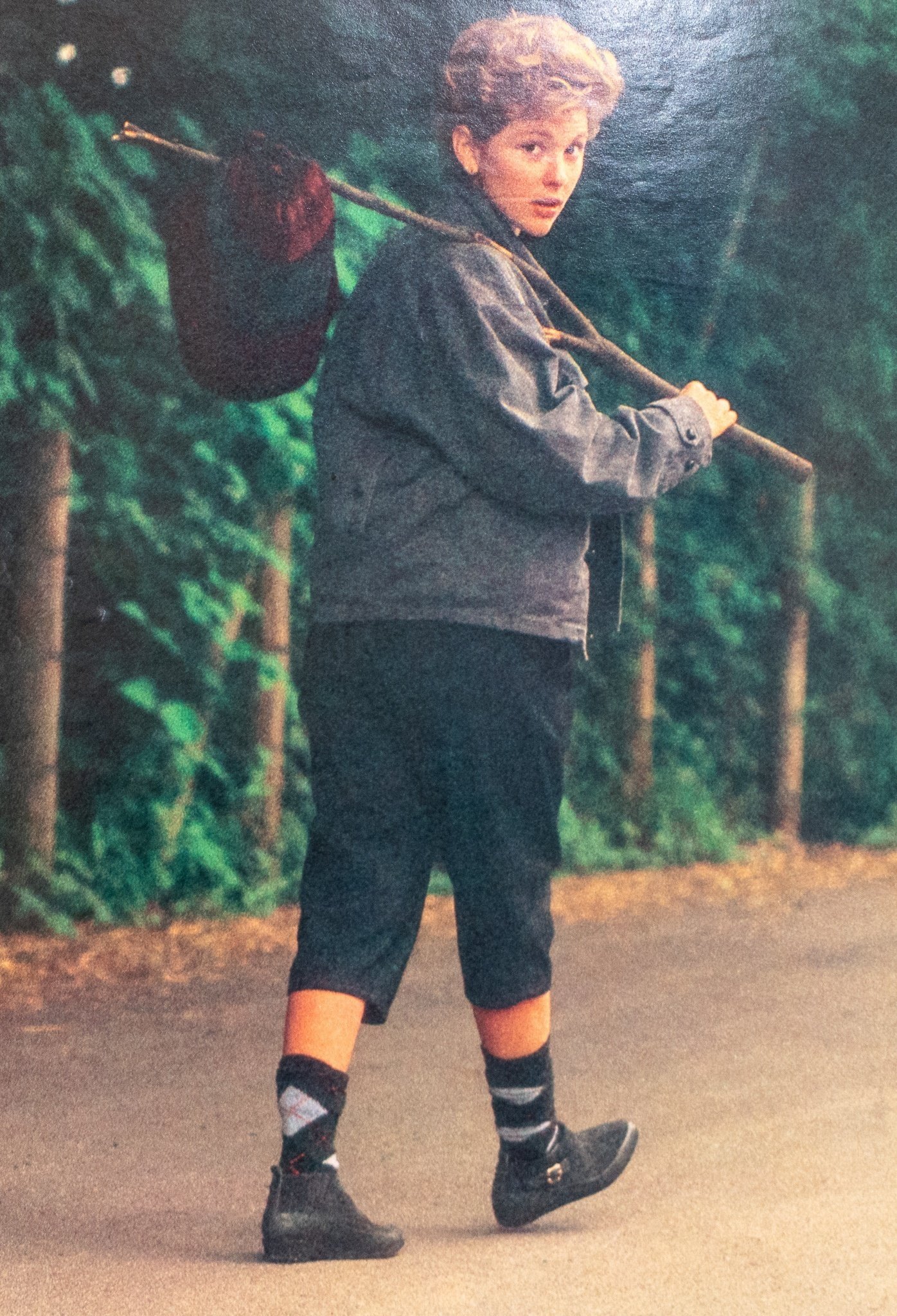
The next page.
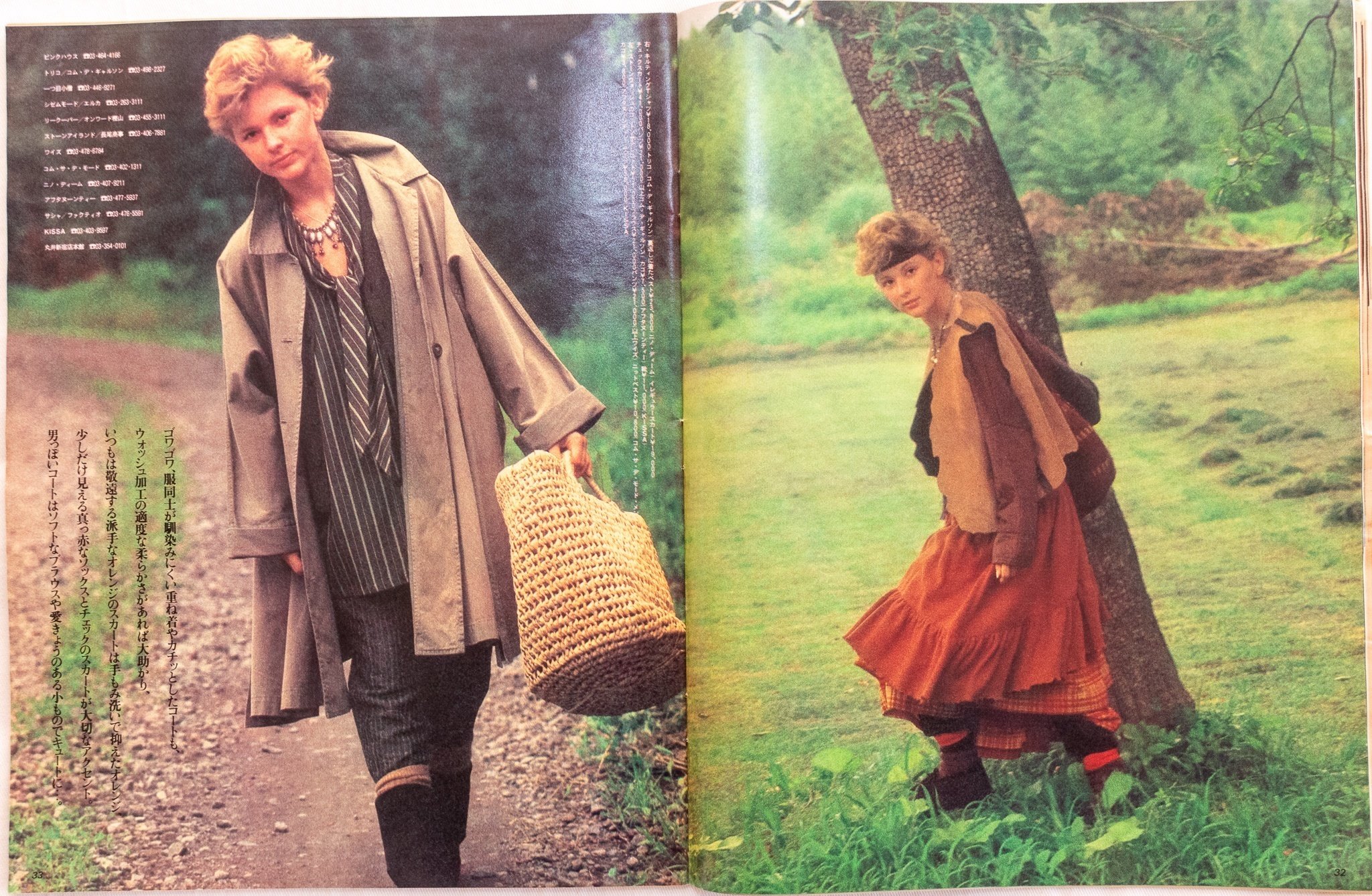
Stiff and layered outfits or sharply tailored coats can be difficult to mix and match, but having the right amount of softness from wash processing can be a great help.
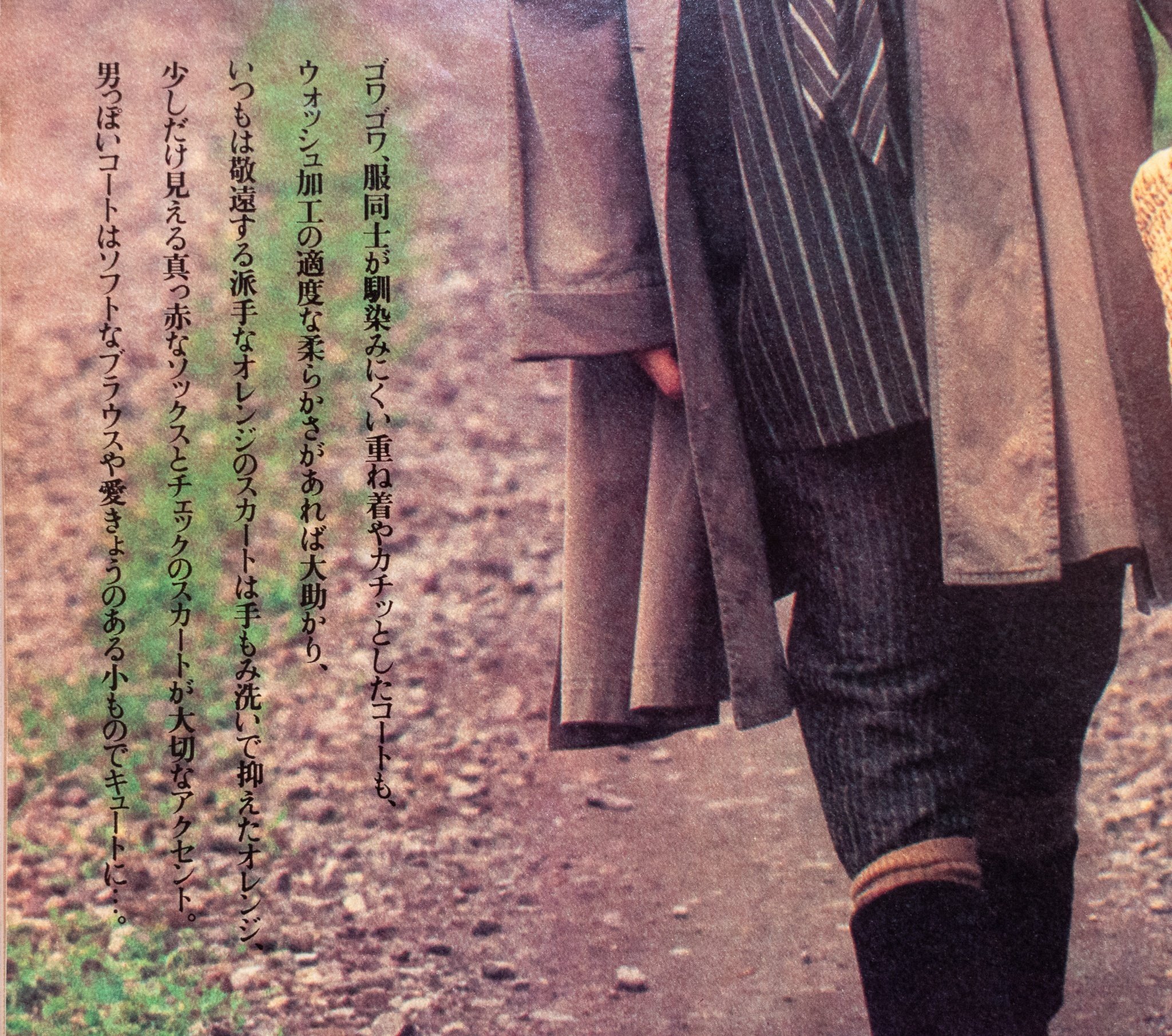
The right page features a folkloric styling with a T-shirt, vest, and skirt.
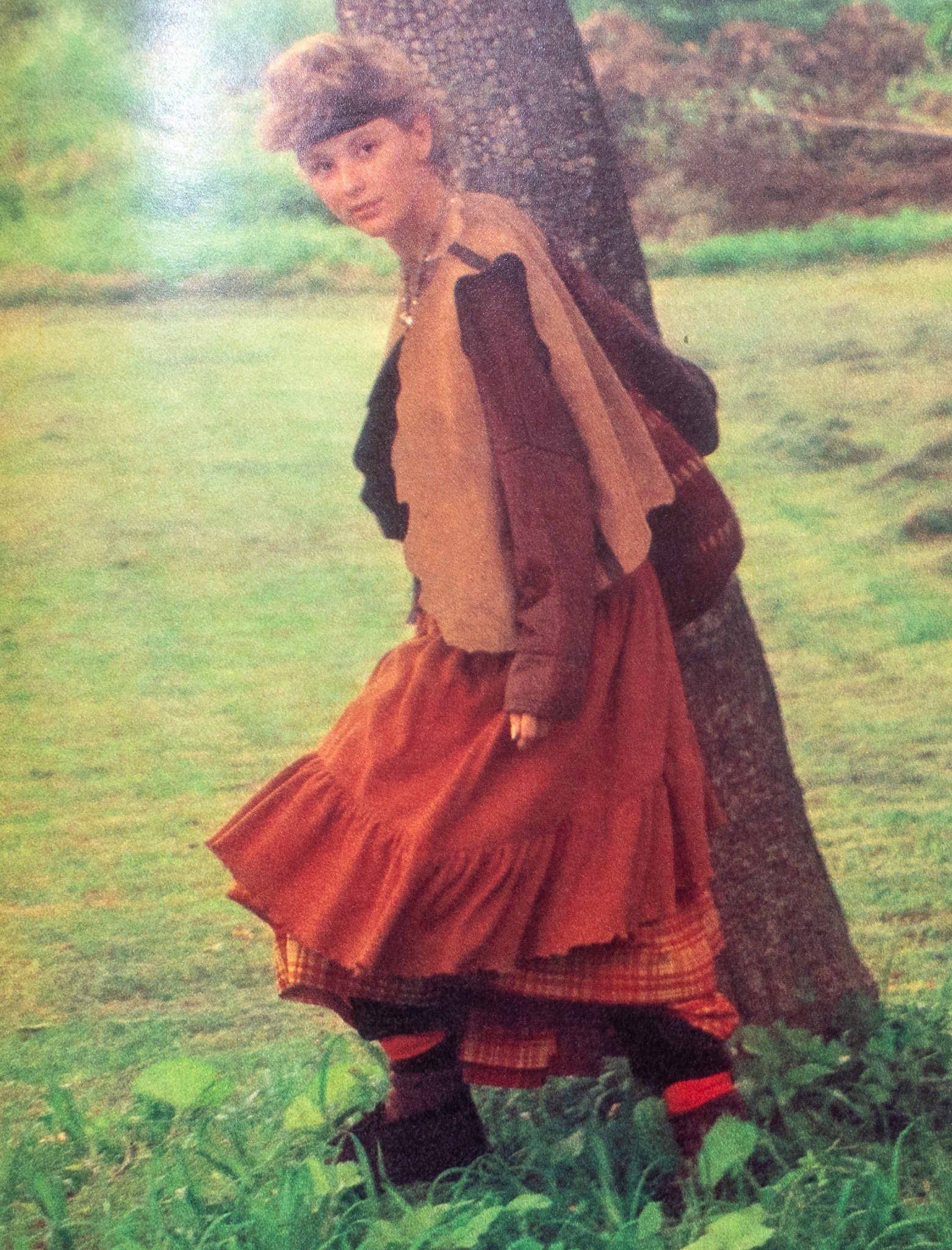
"Looking at the caption, it appears that this T-shirt is from tricot Comme des Garçons. From the notation, it seems that the brand name at the time was 'tricot.' Additionally, the bottoms consist of layering two skirts over pants, all from Comme des Garçons. While Comme des Garçons was known for its 'shock of black' image in the 1980s, it seems they also offered many items in earthy tones like these."
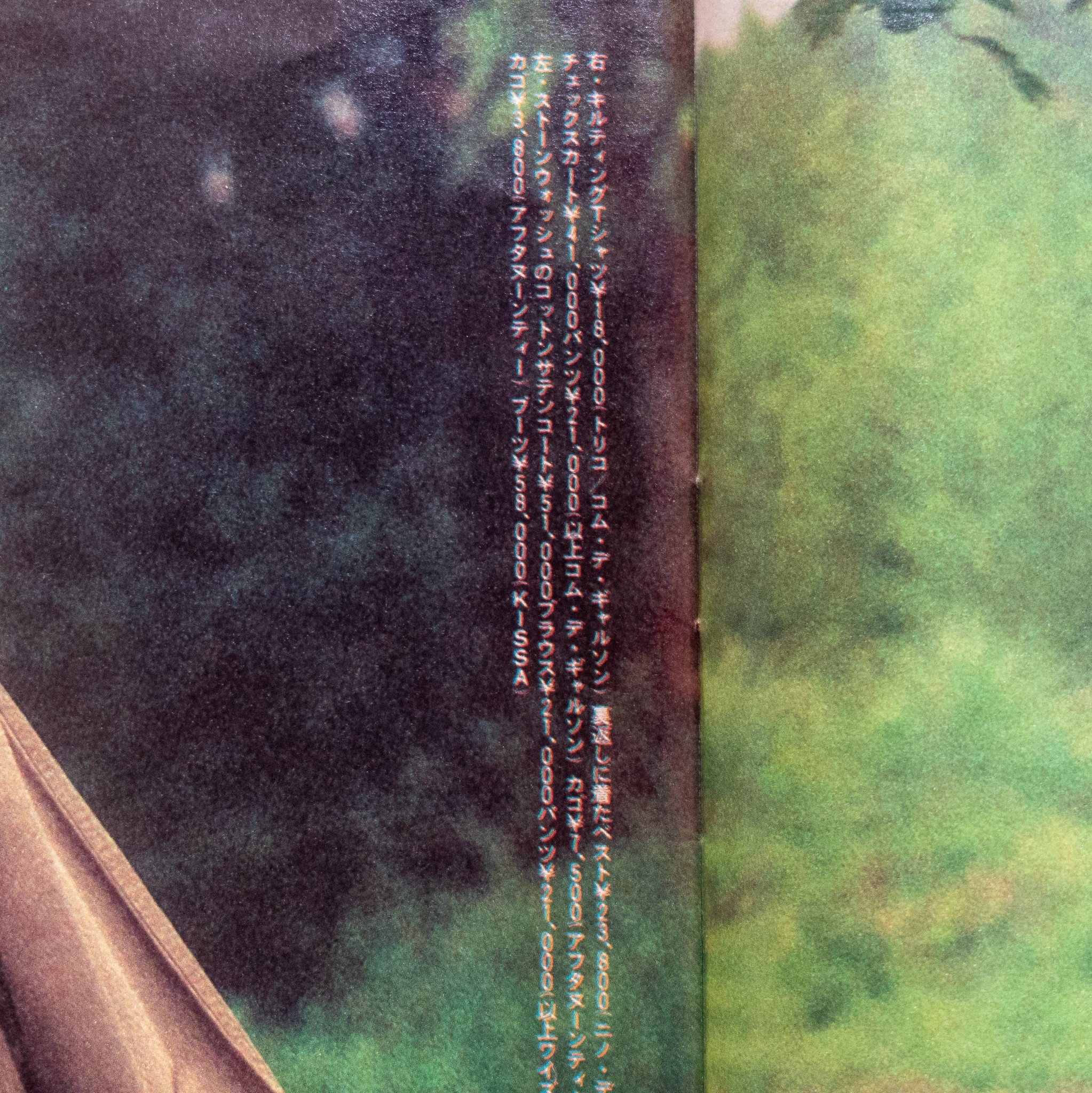
"Explosively popular in Paris and New York, but Japanese manufacturers are still skeptical. Nevertheless, clothing with a vintage feel seems to be catching on."
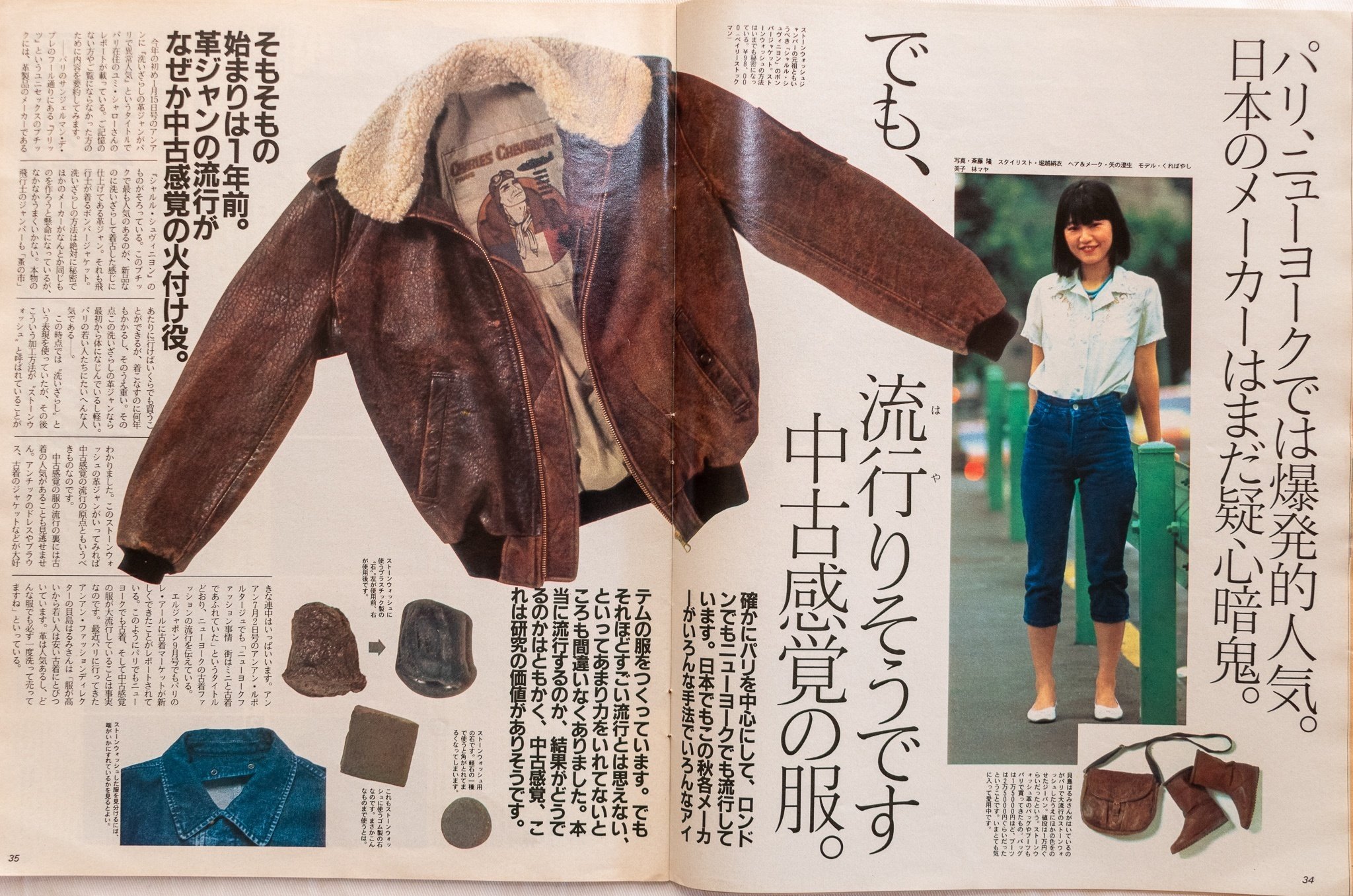
Indeed, it's trending not only in Paris but also in London and New York."
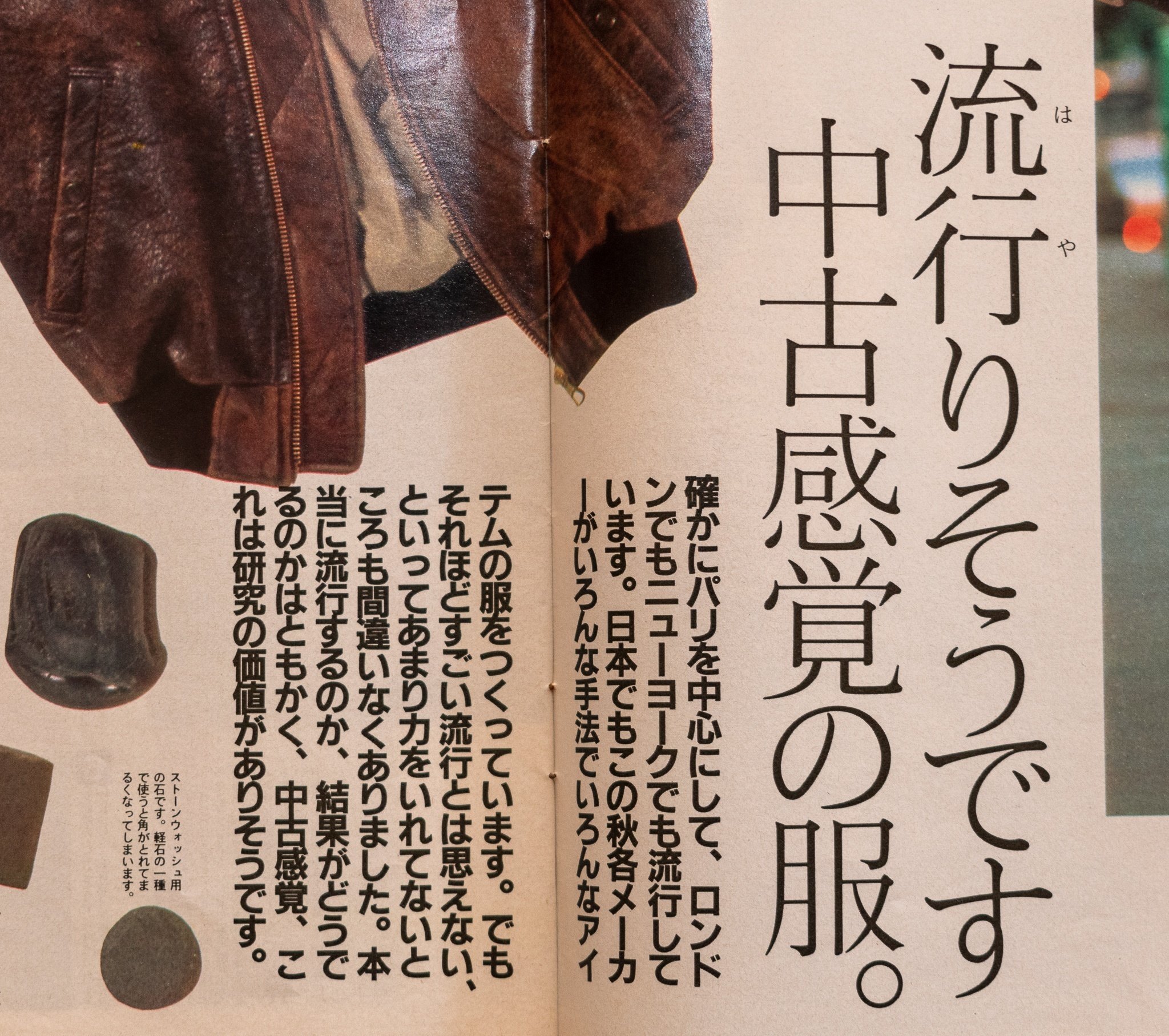
Harumi Kaishima is wearing stone-washed jeans with added colors, which are a big trend in Paris. They cost around 10,000 yen.
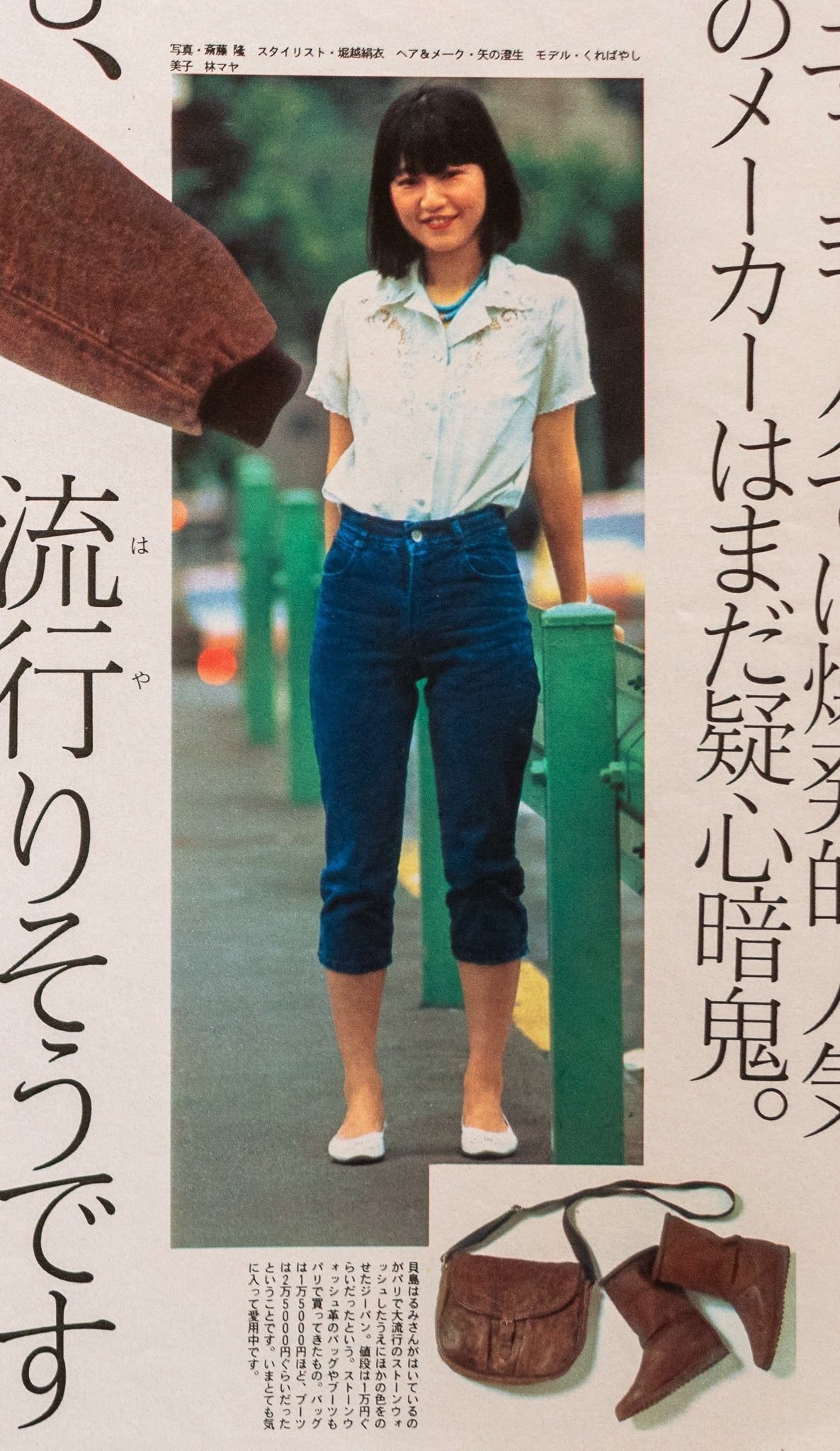
The stone-washed leather bag and boots were also purchased in Paris.
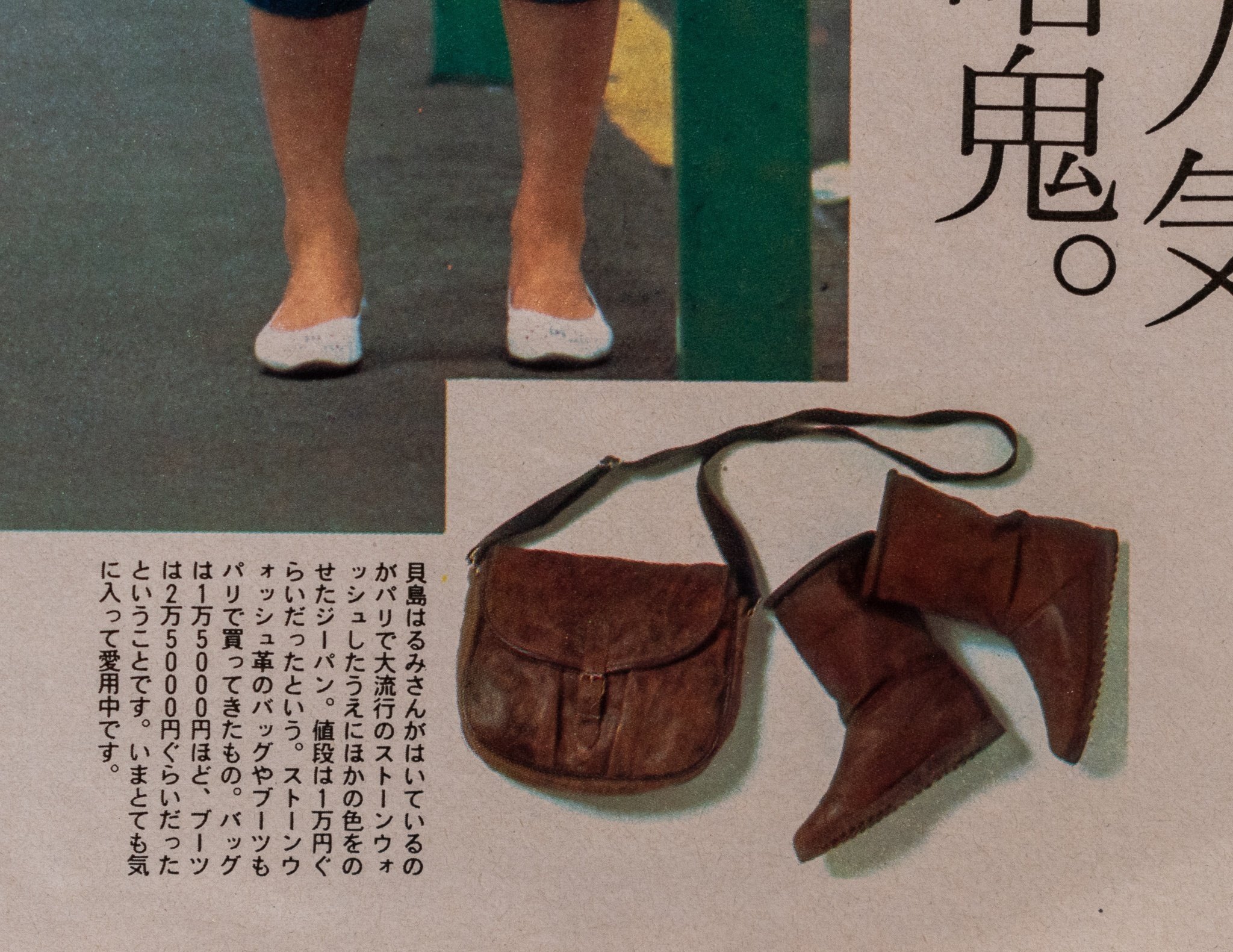
The catalyst for “vintage feel”trend was a leather jacket from Paris.
Featured in the center of the magazine page is a leather flight jacket.
The beginning of it all was a year ago. For some reason, the trend of leather jackets sparked the vintage feel.
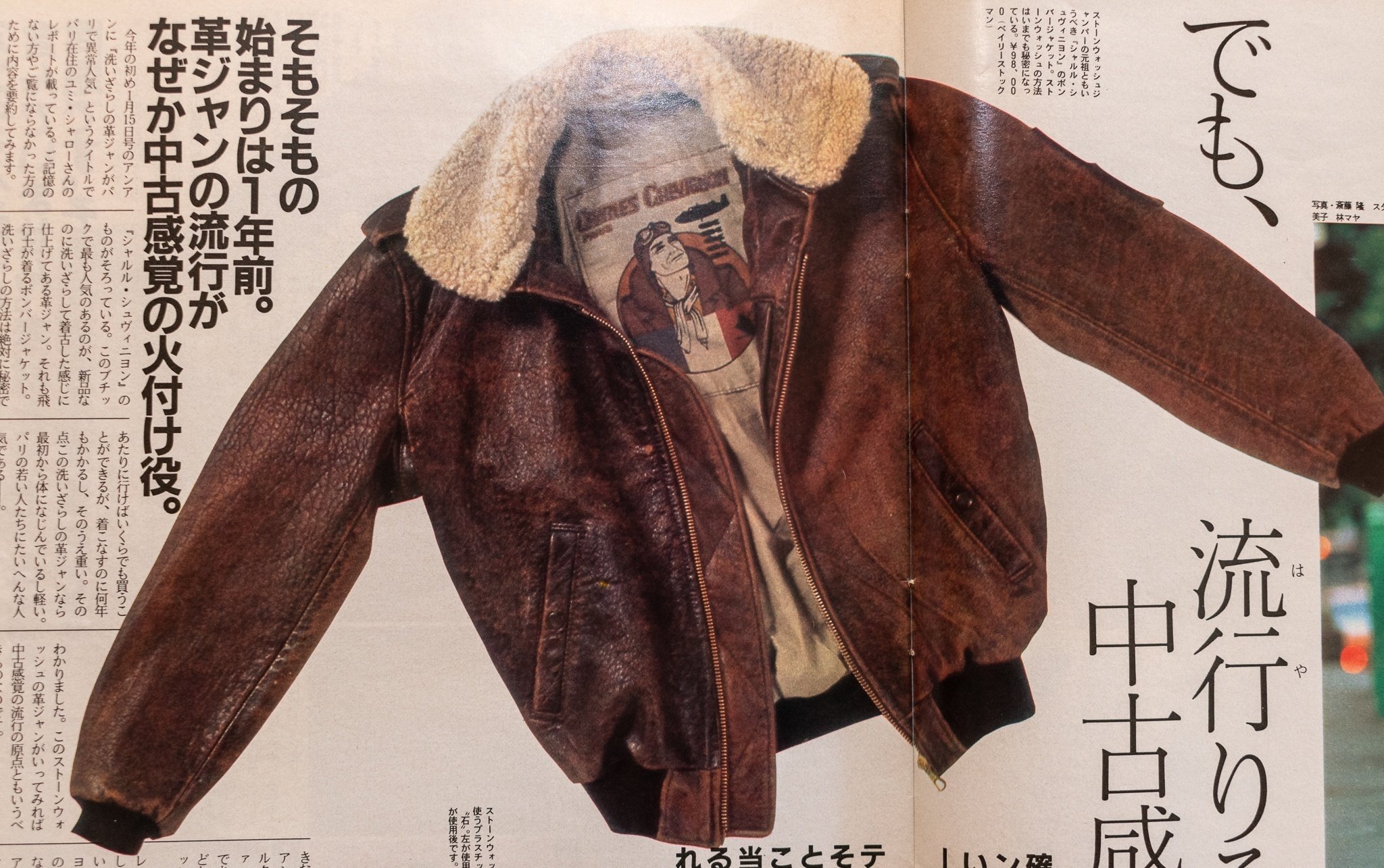
In the unisex boutique "Blitz" on Rue de Four in Saint-Germain-des-Prés, Paris, they stock items from the leather goods manufacturer "Charles Schwabignon." The most popular item in this boutique is a leather jacket that has been given a worn-out look despite being brand new. Particularly, bomber jackets worn by pilots.
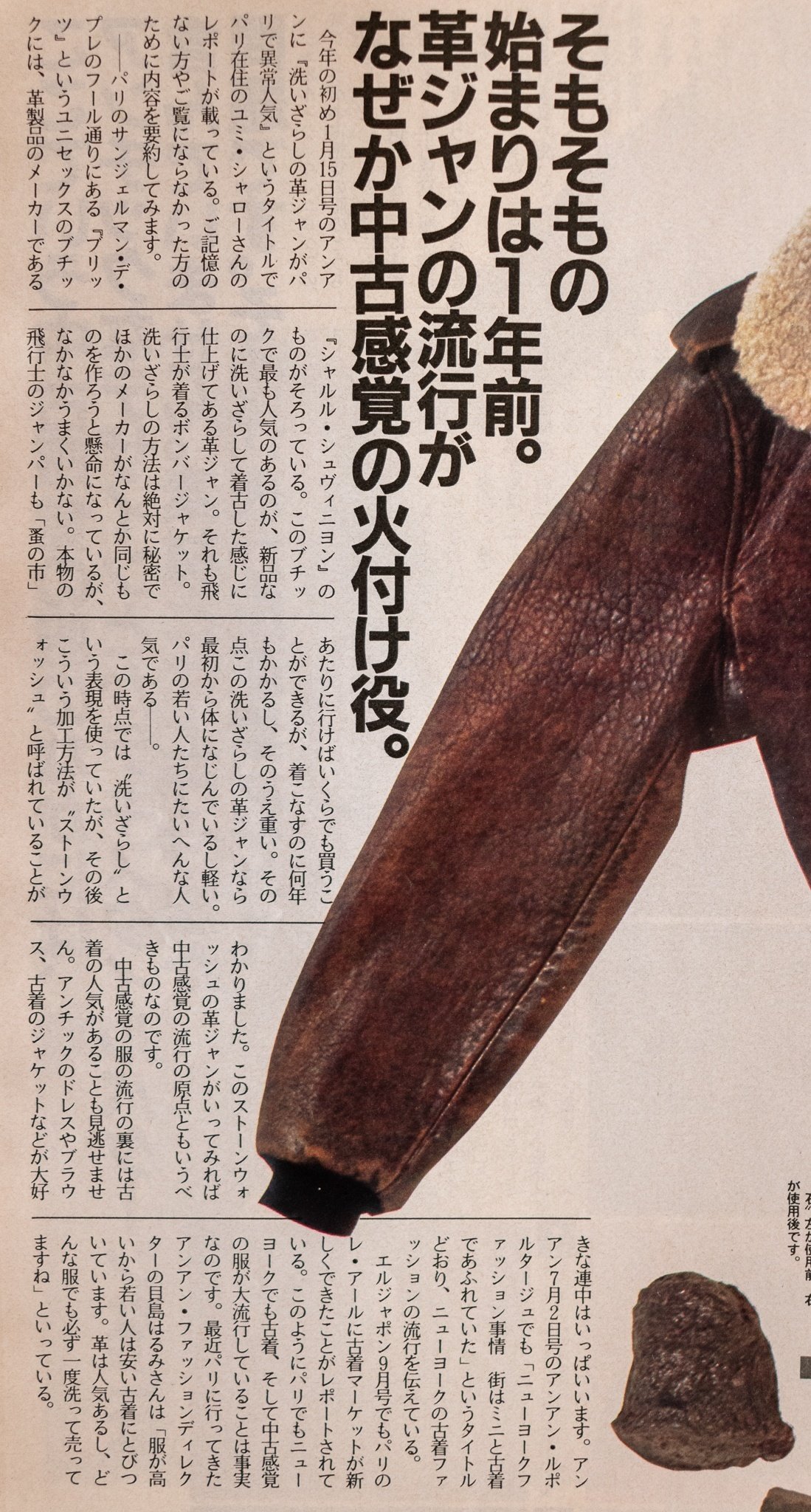
The brand mentioned here as "Charles Chevignon" has changed its name to "Chevignon" and is still active today.

The story of Chevignon's history begins with the story of jackets. In the 1950s, it was the "flight" jacket worn by American pilots. Beauty, comfort, durability. Like this jacket, Guy Azoulay, the creator bearing the name of the Frenchman Charles Chevignon, dreamed of America and expressed mainly American styles and inspirations. He passionately loved vintage clothing, collecting iconic items from the American military and reconstructing them into his first collection. Thus, reinterpreting pieces found around the world became his trademark. In no time, the Chevignon whirlwind swept across the globe. Urban, elegant, and adventurous wardrobe. Timeless. Weave beauty into subtlety. It's wonderfully light-footed.
The leather jacket featured in anan seems to have been a significant item in telling the story of the Chevignon brand.
And the leather jacket, which appears to be from that time, is still available for purchase today on platforms like Yahoo Auctions.
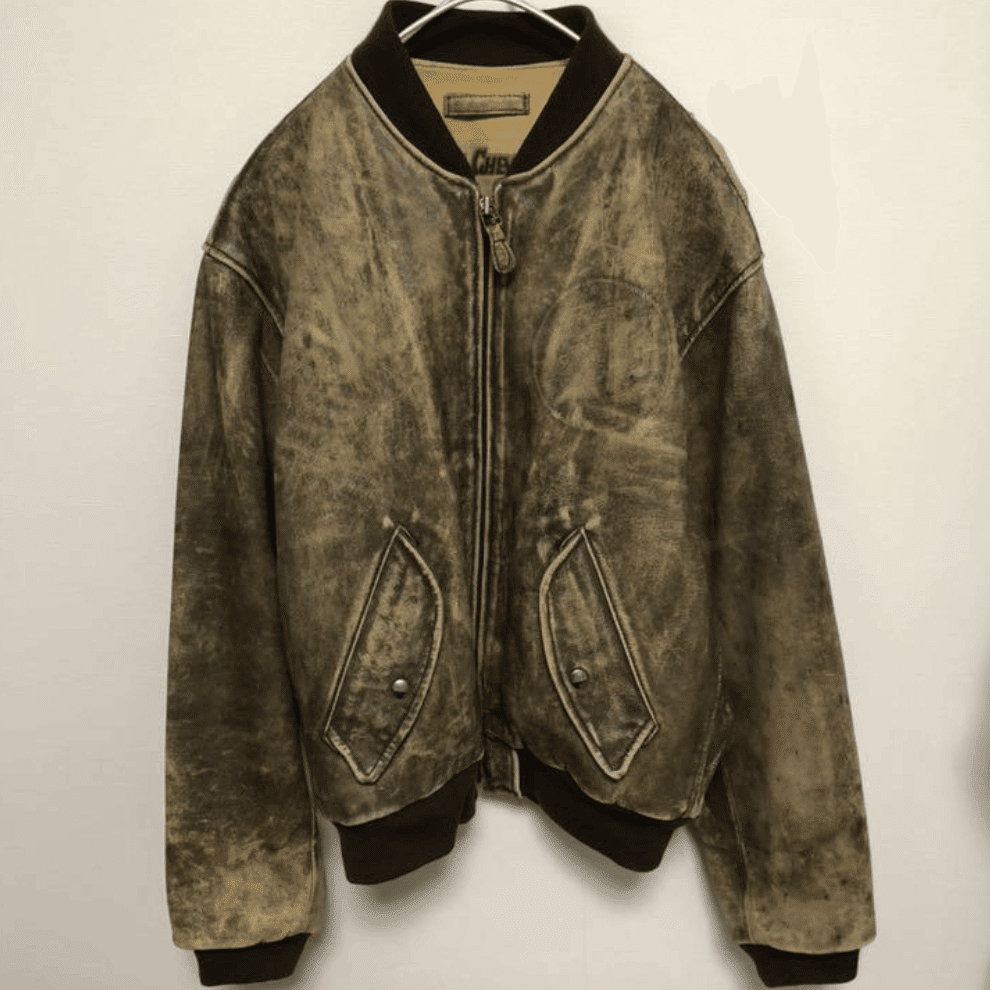
The introduction of the "stone" used in stone washing. Various materials such as plastic, rubber, and pumice are used for this purpose.

Next page.
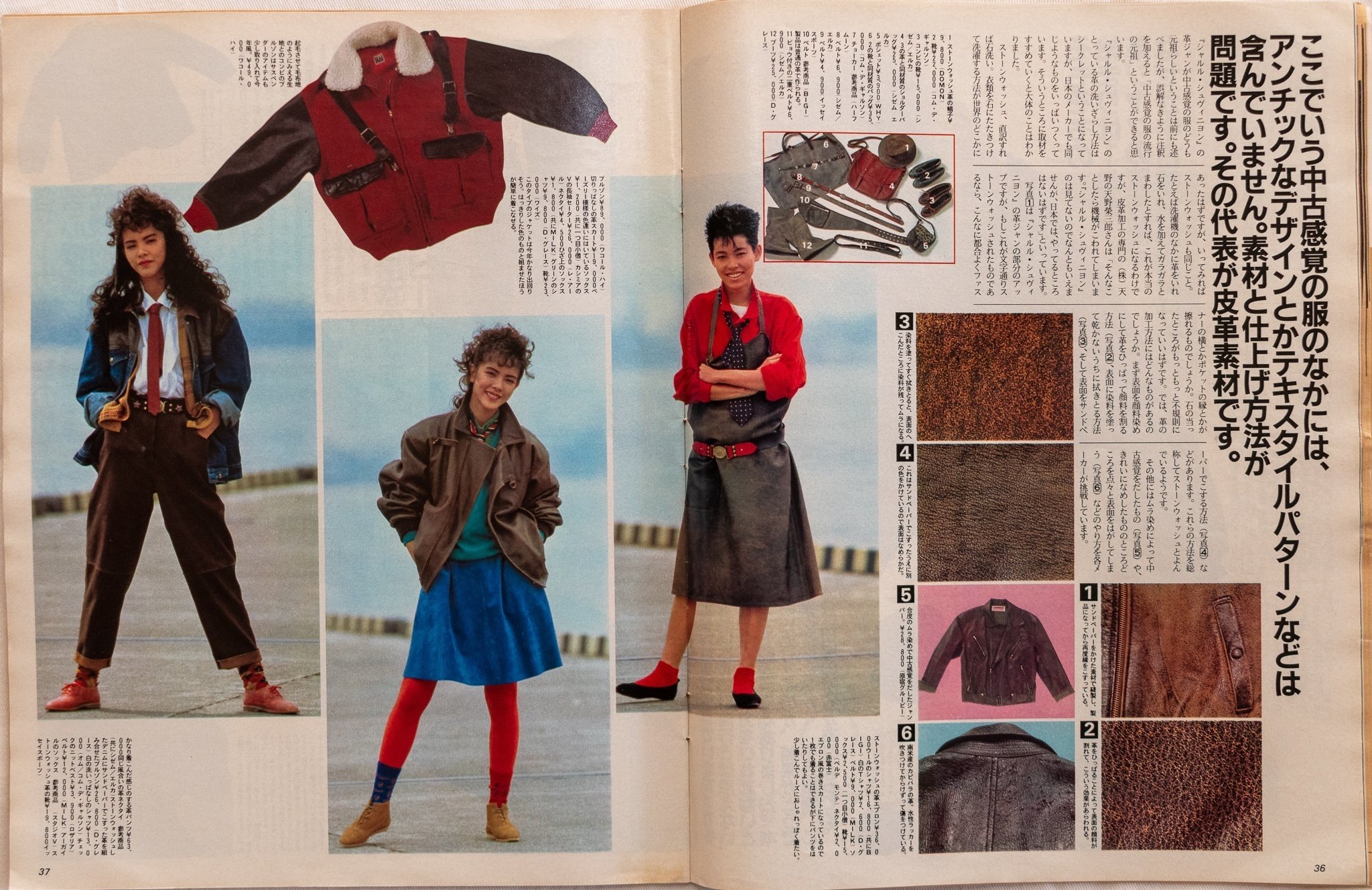
The key points of vintage-style clothing are the materials used and the finishing techniques.
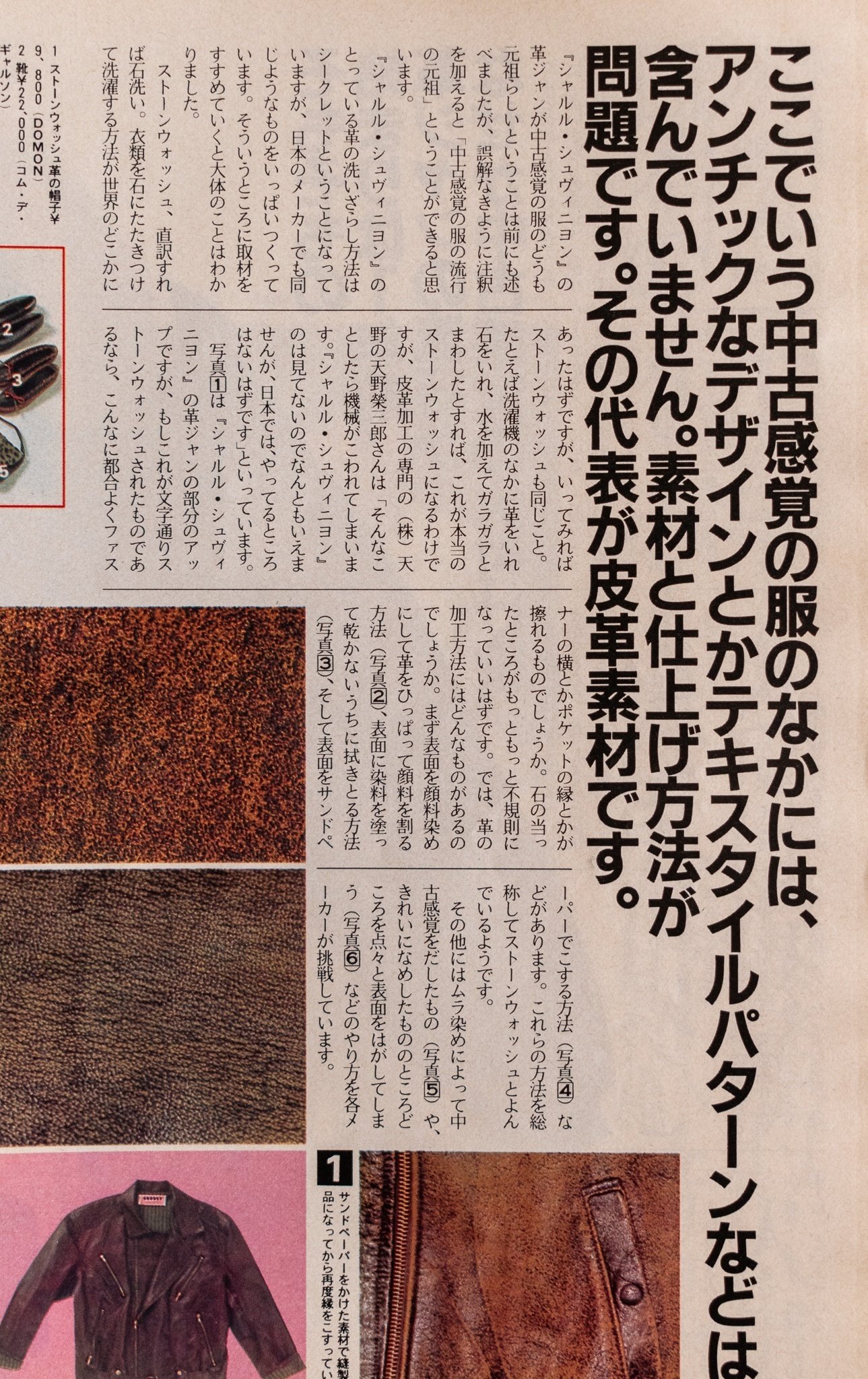
The processing of leather materials, which is representative of this, involves techniques such as pulling and breaking pigments after pigment dyeing, applying dye and wiping it off before it dries completely, and rubbing the surface with sandpaper. These methods are collectively referred to as "stone wash."

Numerous leather goods featuring stone wash processing. The black pumps in item 2, and the bags in items 5 and 6 are from Comme des Garçons. The tote bag in item 6 has remained a staple item since the 1990s, with similar shapes being offered in various materials and colors.
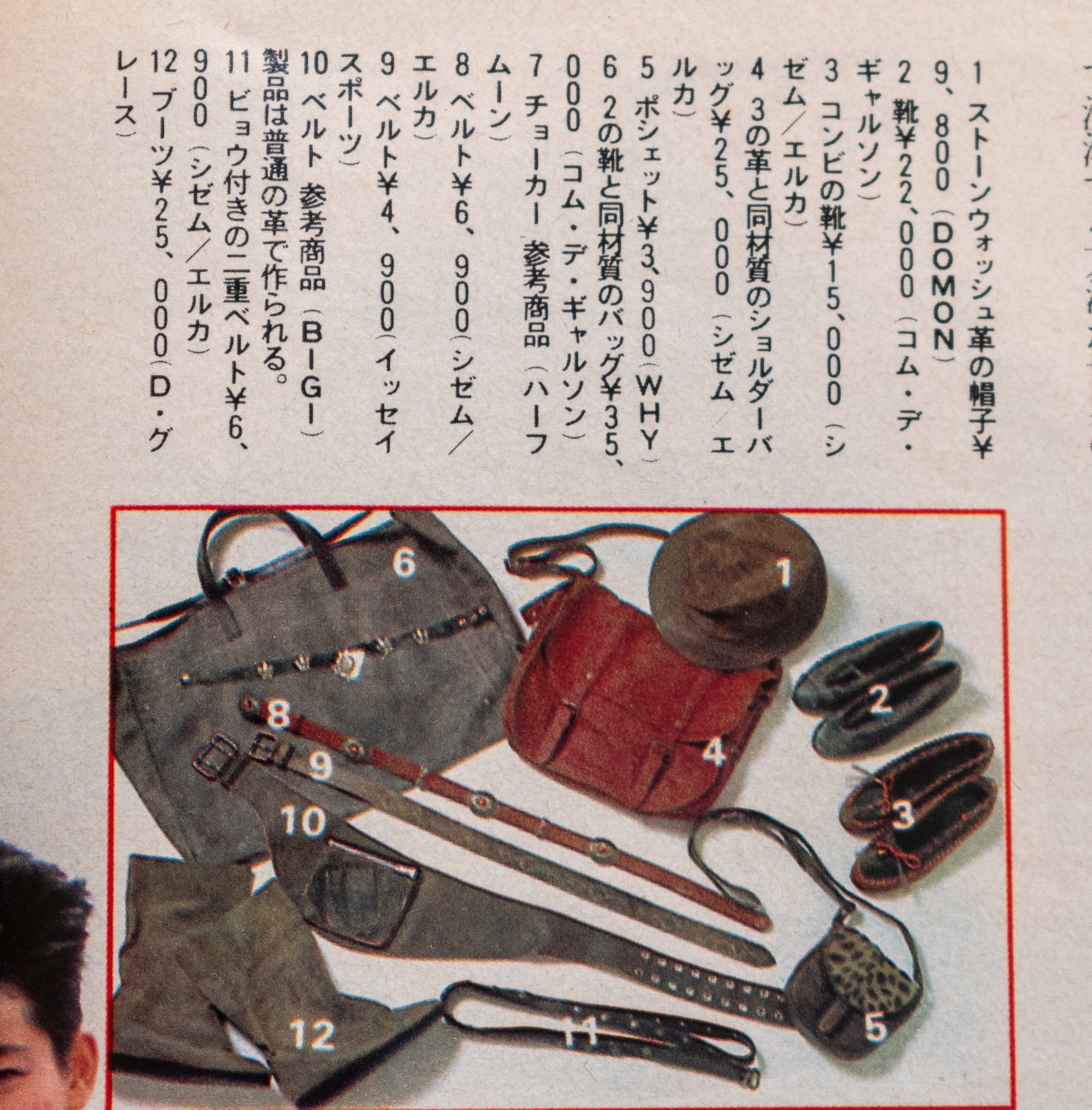
A blouson from the brand "Wacoal Hia." Is it a brand developed by the underwear manufacturer Wacoal? I tried Googling it, but I couldn't find any information.

The "washed-out white shirt" used in this styling is from Comme des Garçons Homme, of course, for men. This is from the era when Rei Kawakubo was designing for the brand.
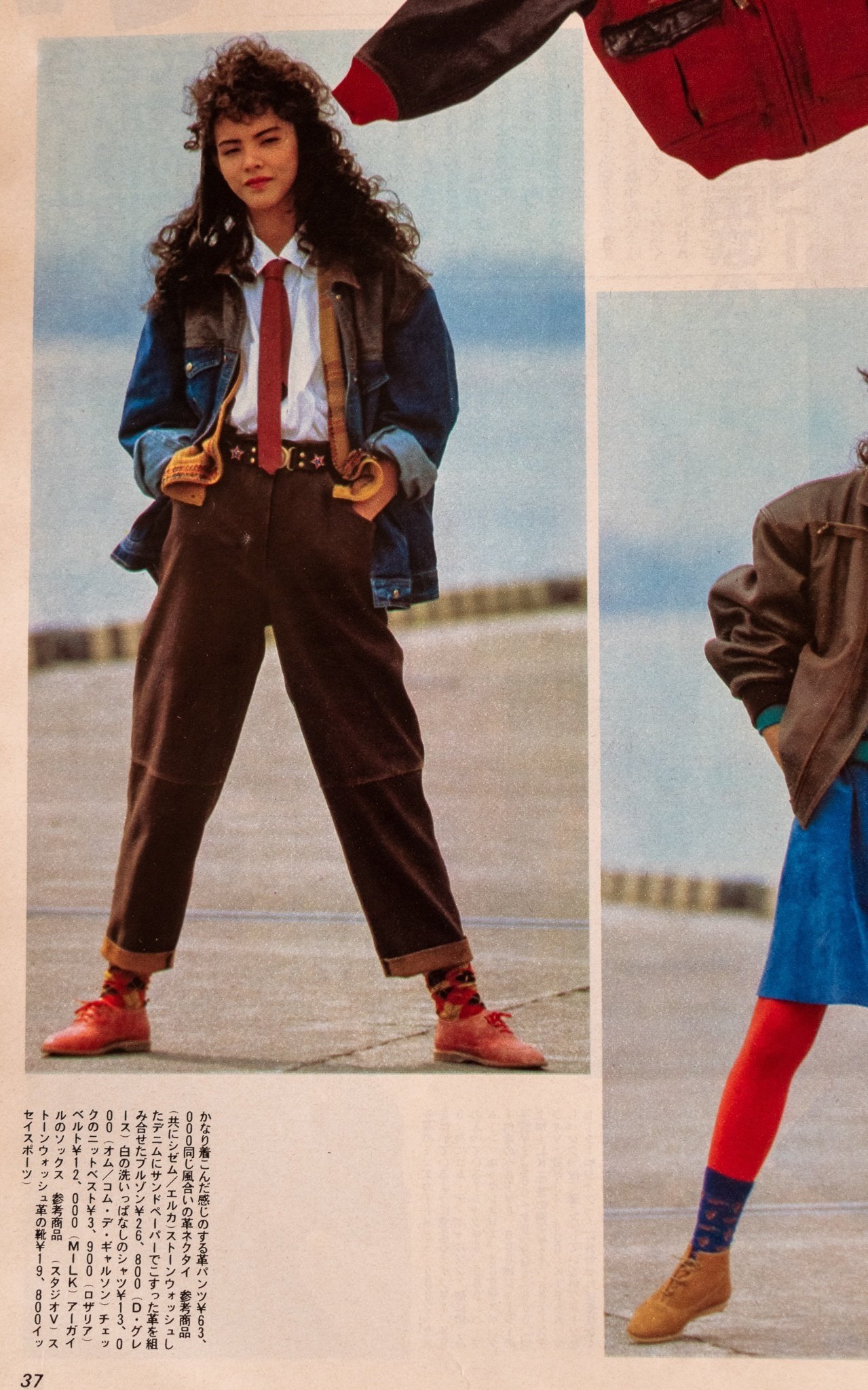
On the styling to the right, it appears to be a dress, but it's actually a stone-washed leather apron. It's an item from BIGI, along with the shirt.
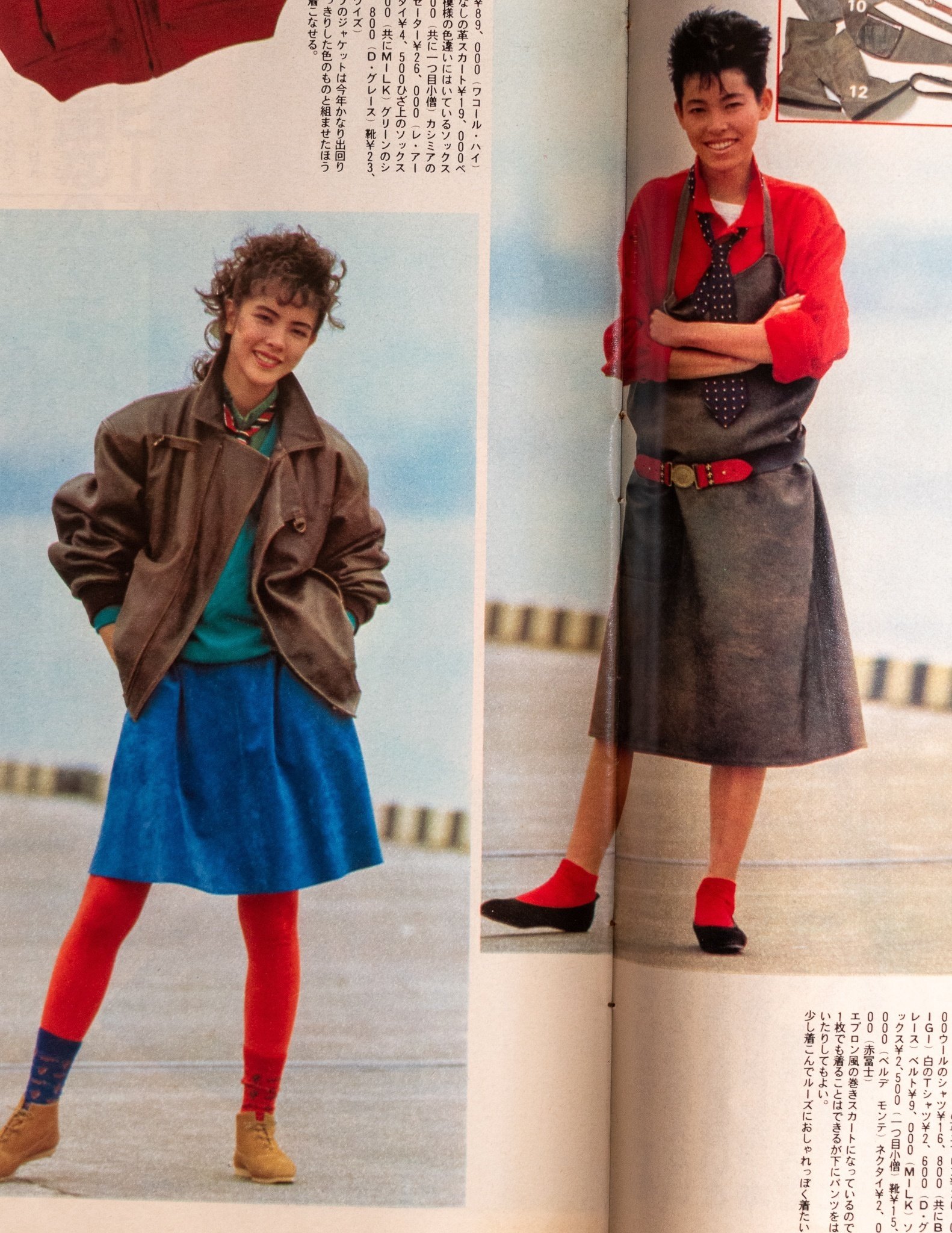
And personally, what was quite shocking to me was this page.
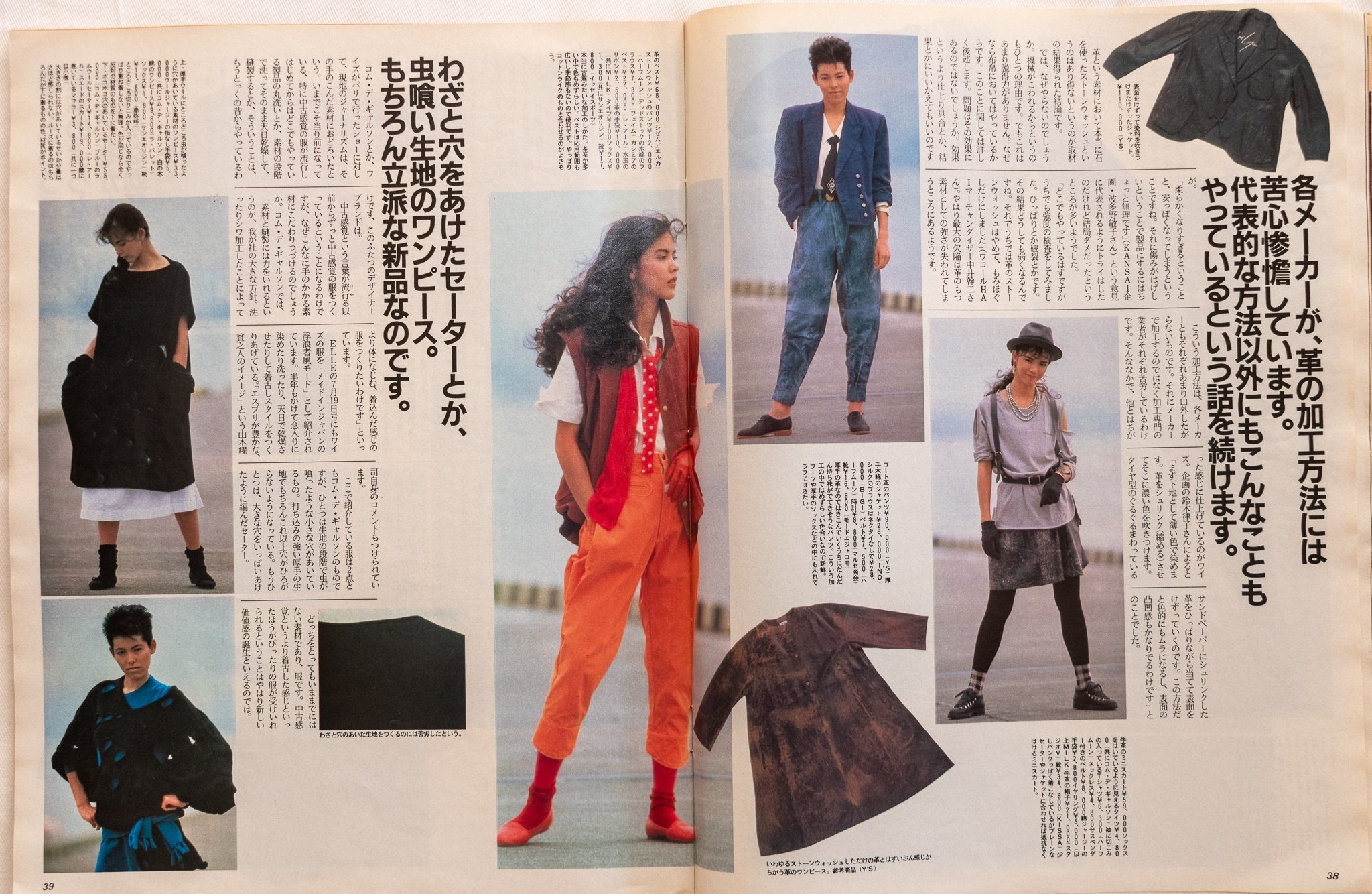
"Each manufacturer is painstakingly working on leather processing methods."
The jacket in the top right corner is from Y's. "First, we dye the leather with a light color as a base. Then, we shrink the leather and spray a darker color onto it. We use sandpaper shaped like a tire, rotating it while pulling the shrunken leather against it to shave off the surface. This method results in uneven coloring and significant texture on the surface, requiring quite a bit of effort."
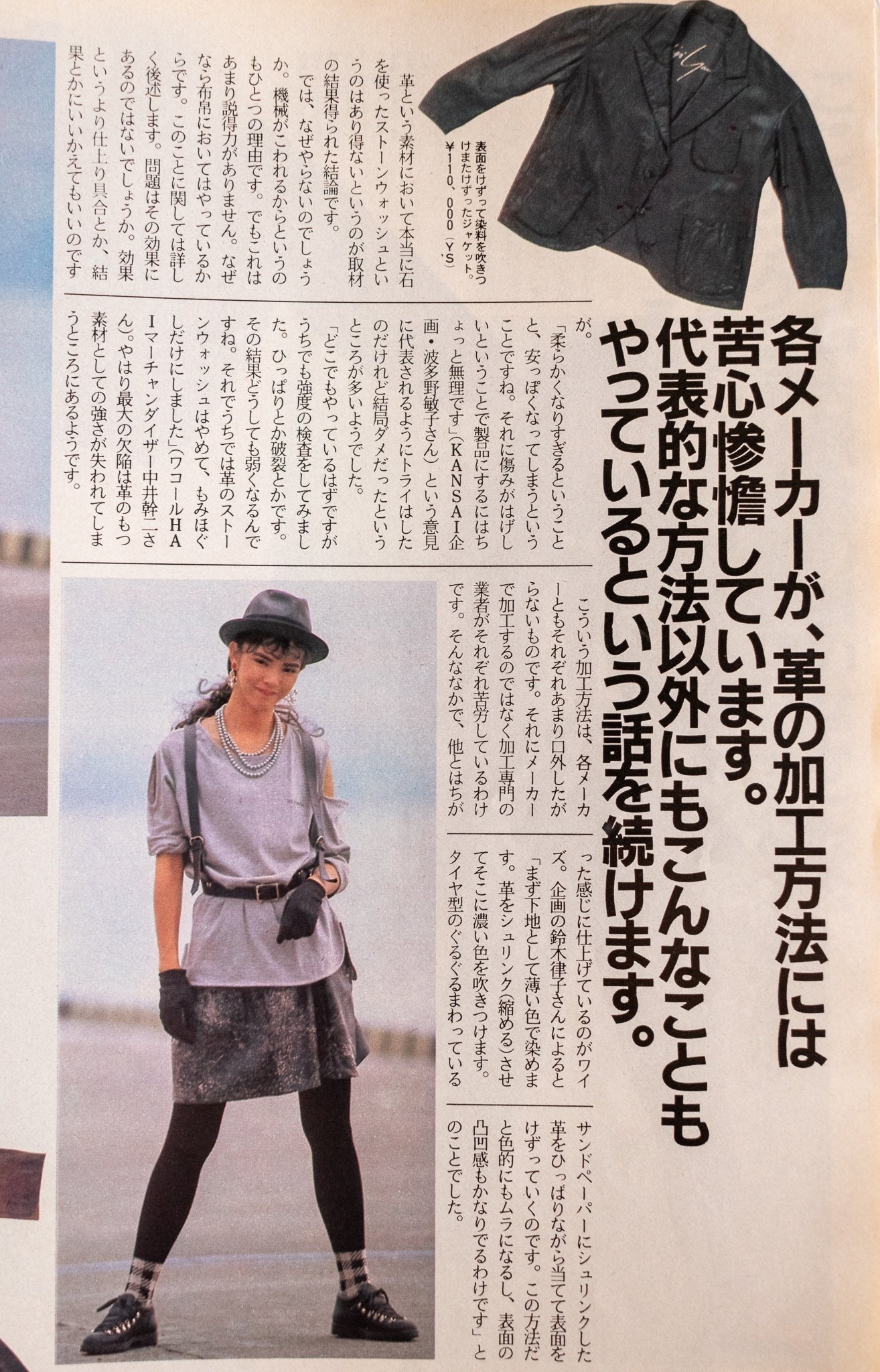
The mini skirt made of cowhide and the tights that appear to be worn with socks are from Comme des Garçons. A mini skirt from Comme des Garçons is also quite a surprising item.

The legendary "Black Shock" distressed knit.
The climax or highlight of this article is here: "Intentionally distressed sweaters with holes, or dresses made of fabric with moth holes. Of course, they are all perfectly new."
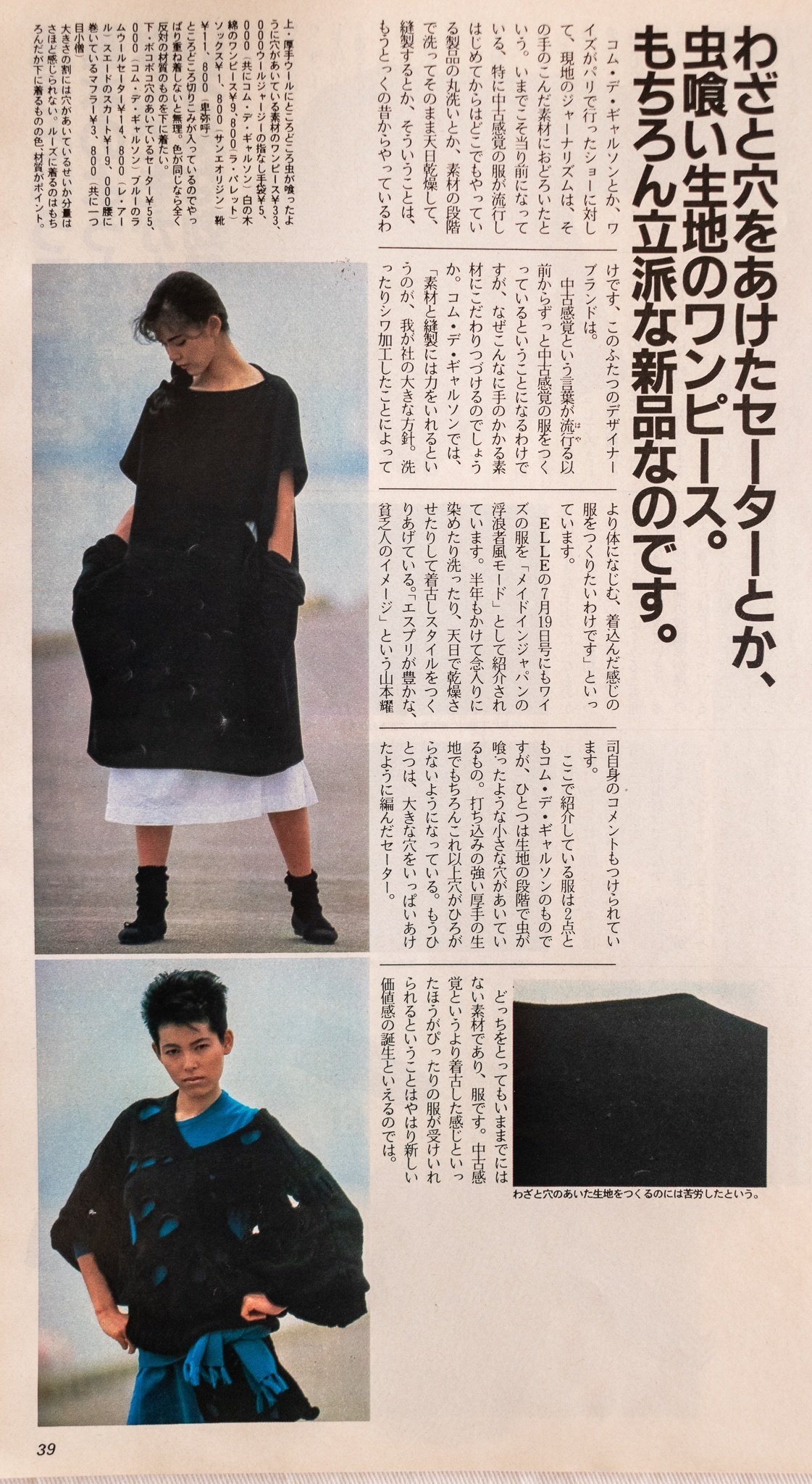
It's quite evident, but the item that symbolizes the epoch-making "Black Shock" still shining brightly in fashion history is Comme des Garçons' distressed knit with holes.

This is it! This is it! It's the knitwear that's sometimes referred to as the "tattered look" or the "atomic bomb look." If you're a fashion enthusiast, you've probably seen it at least once.
 https://www.pinterest.jp/pin/28358672646889739/
https://www.pinterest.jp/pin/28358672646889739/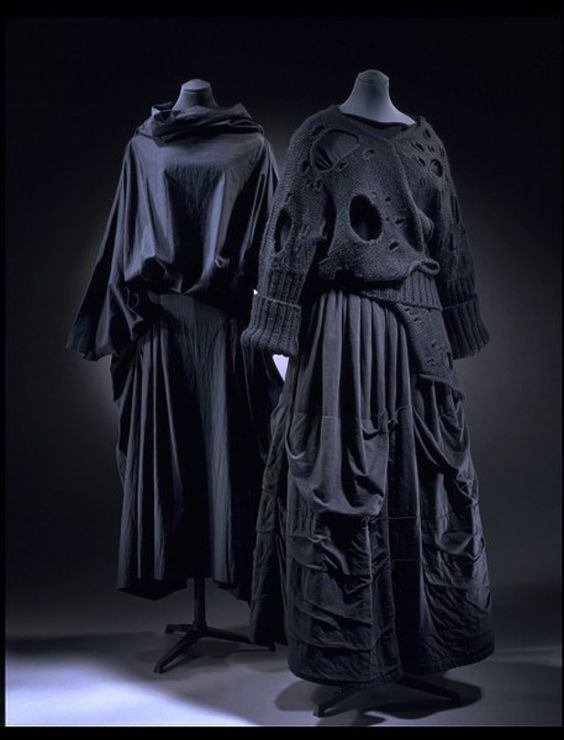 https://www.pinterest.jp/pin/786300416187969597/
https://www.pinterest.jp/pin/786300416187969597/
For me, I always associated this distressed knit with something like an art piece you'd see in an exhibition. So, seeing it used in a magazine styling like this was quite surprising for me.
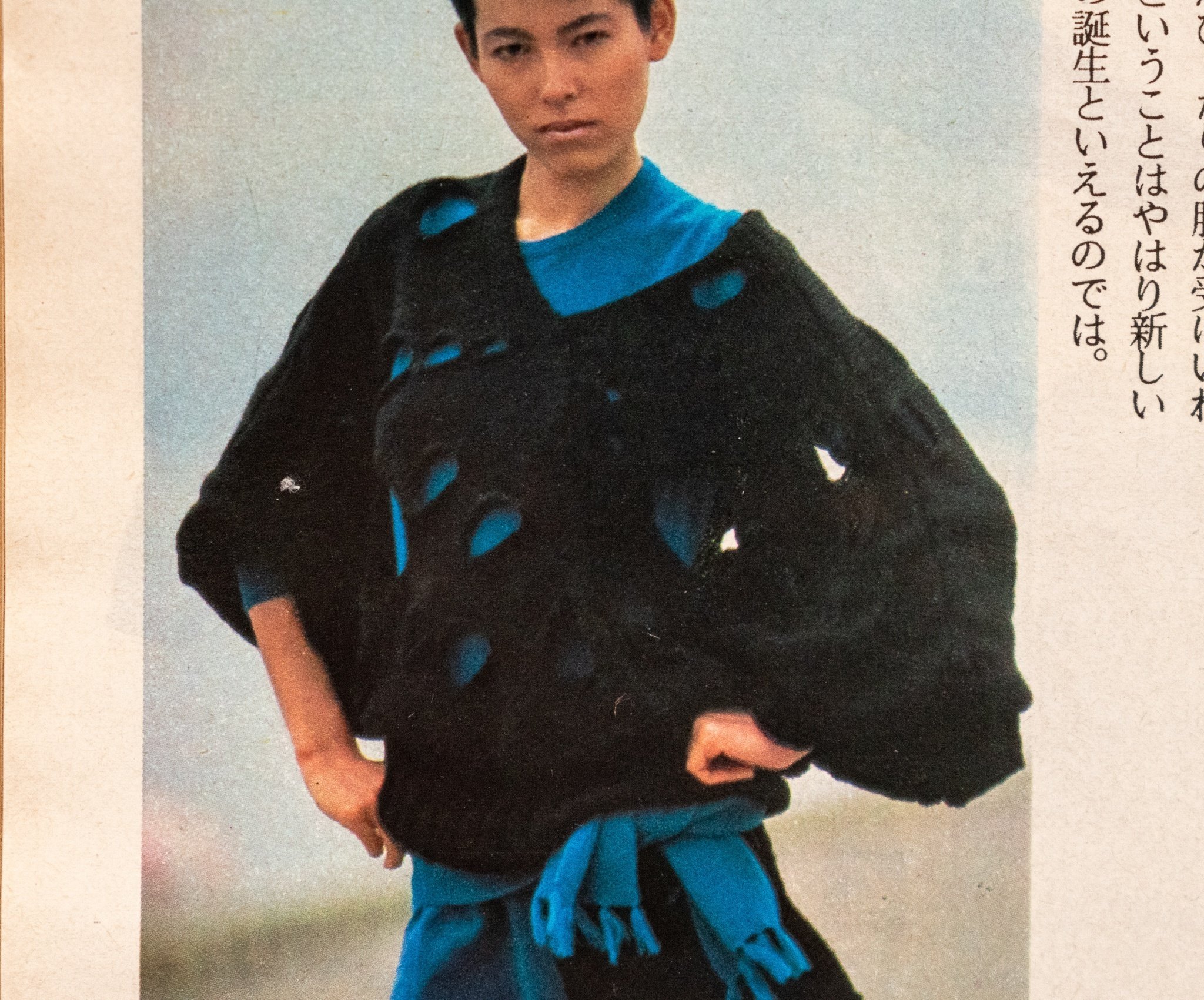
Of course, the price is clearly listed as well: "Sweater with bumpy holes: ¥55,000." If this item were still available, I wonder how much it would be priced at now. According to the product description, despite its size, the quantity doesn't feel significant due to the presence of the holes.

Back then, the value of "vintage feel" was considered more innovative than simply the color "black."
Let's take another look at the text on the page.
Comme des Garçons and Y's shocked the local journalism scene in Paris with their shows featuring such unconventional materials. Now it's commonplace, especially since the rise of vintage-style clothing, to see products that have been thoroughly washed or sun-dried at the material stage before sewing, but these two designer brands have been doing it for ages.
Even before the term "vintage feel" became popular, they've consistently created clothing with a vintage feel. But why do they continue to focus on such labor-intensive materials? At Comme des Garçons, they say, "We prioritize materials and sewing as our major policy. We want to create clothes that feel like they've been worn in, that blend with the body more naturally due to washing and wrinkle processing."
Wise's clothing was also introduced in the July 1st issue of ELLE as "Made in Japan's vagrant-style fashion." They meticulously dye and wash their clothing over a period of six months, air-drying them to achieve a worn-out style. Yamamoto Yohji himself adds the comment, "A rich spirit in the image of the poor."

This page inevitably draws attention to the distressed knitwear, but here's another item from Comme des Garçons. It's not very clear in the photo, but it's a dress made of thick wool with holes scattered as if eaten by insects. (The semi-circular white shape from the abdomen to the hem is a dent in the paper and not part of the garment's design.)
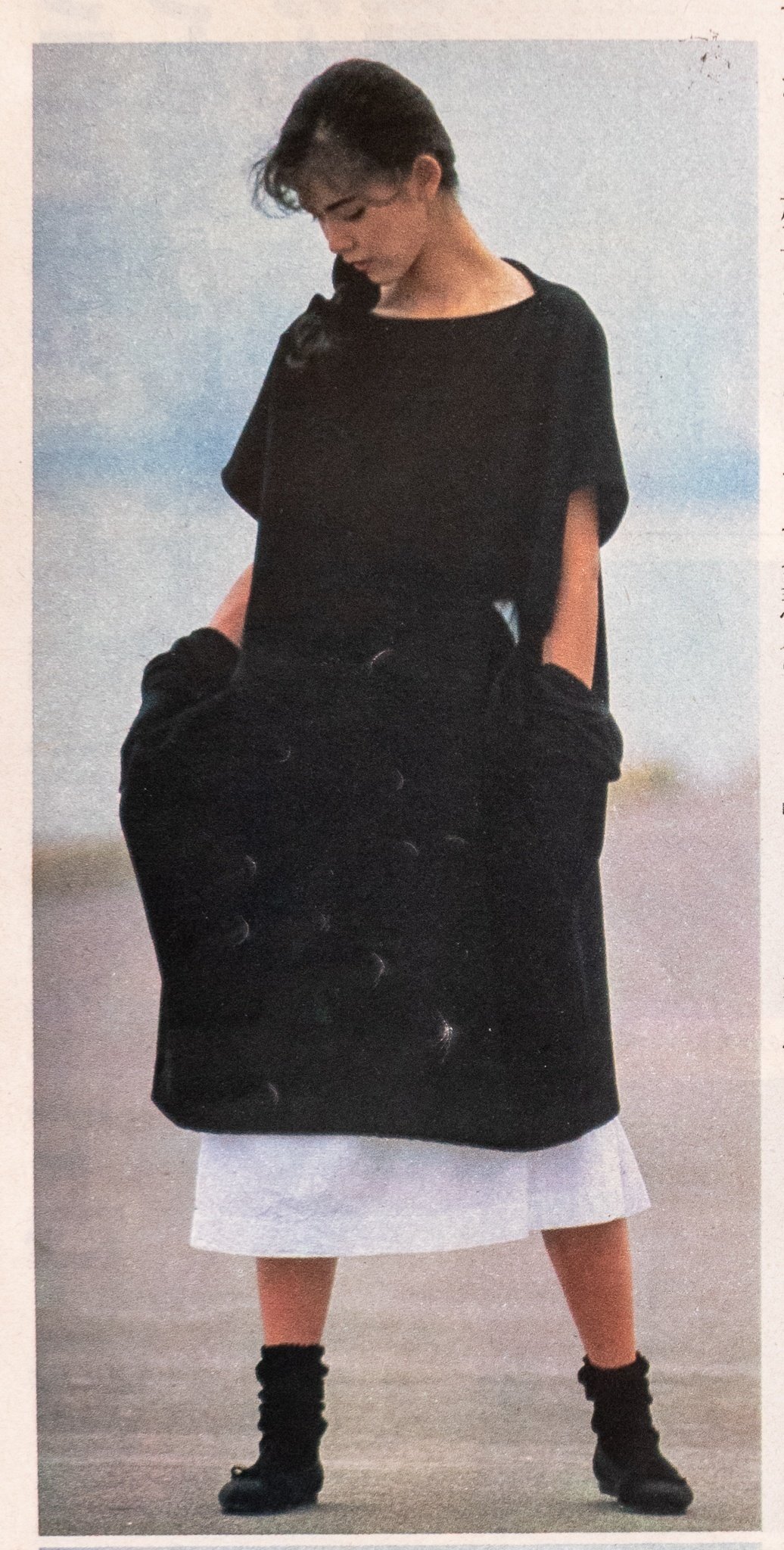
Here it is: "Of course, even with thick, sturdy fabric like this, the holes won't spread any further." And as the conclusion to the introduction of this Comme des Garçons piece, it reads:
Next sentence is extremely important.
Both the material and the clothing itself are unprecedented, whether taken individually. The acceptance of clothing that embodies a worn-in feel rather than merely a sense of vintage reflects the emergence of a truly new perspective on values.
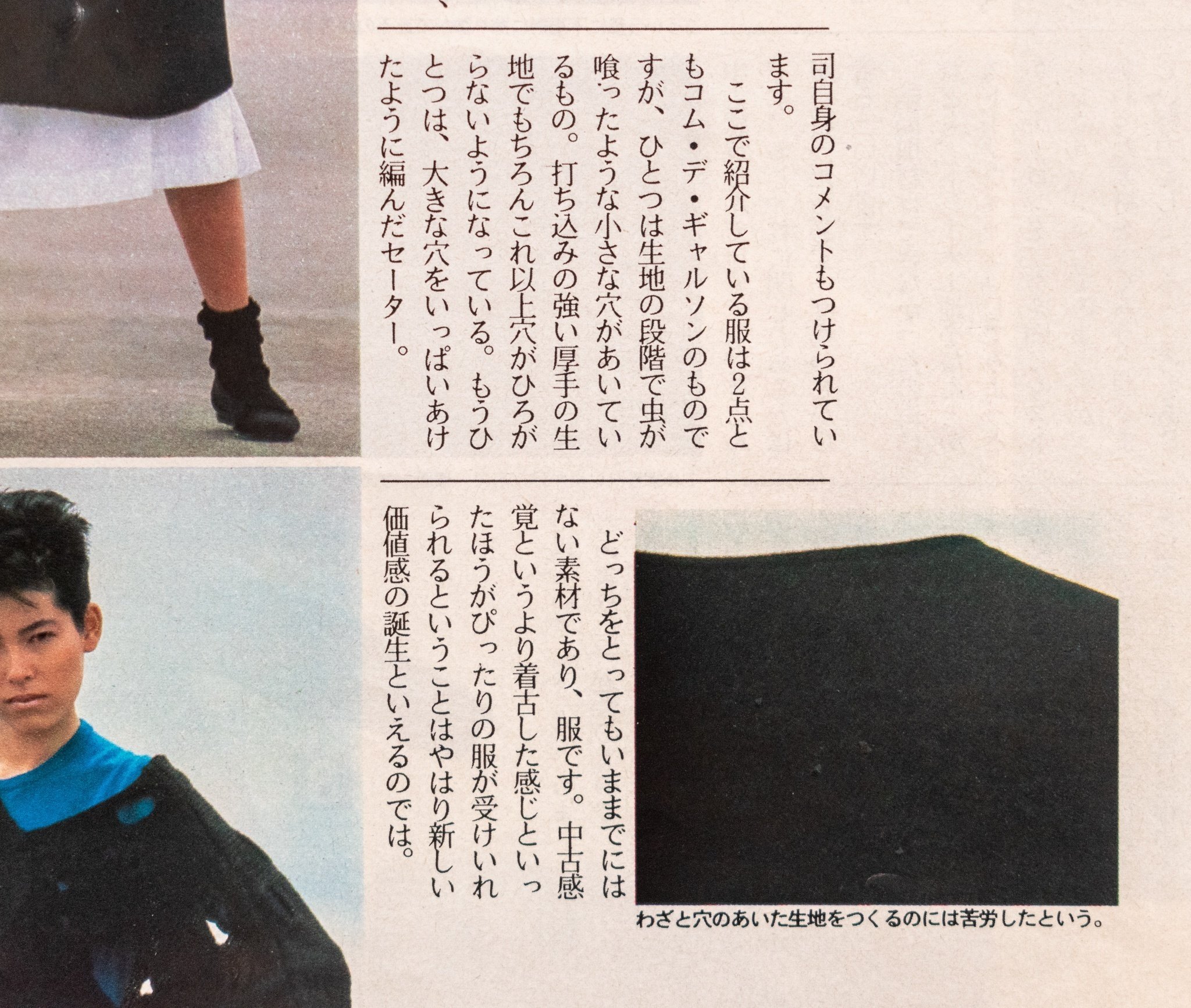
In other words, at that time, both Comme des Garçons and Yohji Yamamoto represented a fresh perspective on the "used aesthetic." Unfortunately, I don't have it on hand, but in other magazines I've read before, there was discussion about how Comme des Garçons' clothing, with its vintage-like quality, was considered innovative.
We've touched on this multiple times, but for us today, the emergence of Comme des Garçons and Yohji Yamamoto feels like a "shock of black," underscoring how revolutionary the color black was. However, from this article, we can see that back then, the novelty of the "used aesthetic" was more significant as a new value system than just the color black.
In the description of Issey Miyake's items later in the magazine, it says, "You'd think it's old if you don't mention it's new, like a jacket made of Nell fabric that seems like something you'd wear if you wanted to look like you're wearing something old."

In other words, wearing clothing with a "used aesthetic" wasn't considered fashionable until then. The emergence of Comme des Garçons and Yohji Yamamoto wasn't just a "shock of black," but rather a "shock of the used aesthetic."
Next page.
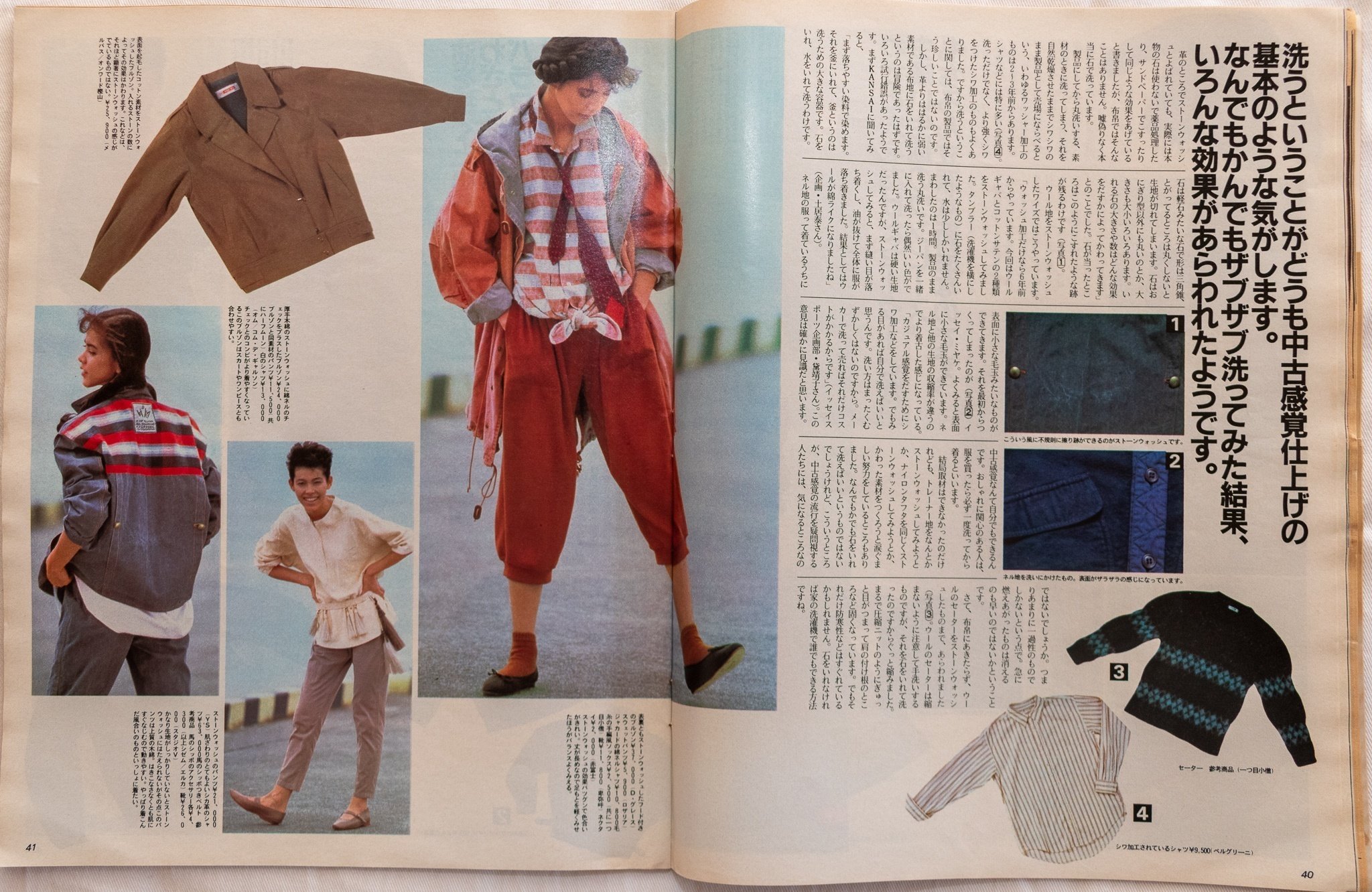
"It seems like washing is somehow the fundamental aspect of achieving the used aesthetic. After trying to wash everything vigorously, various effects seem to have emerged."

In fact, the actual washing techniques of Y's and Issey Miyake are introduced by their respective project staff. First up is Y's.
This time, we tried stone-washing two types of fabric: wool gabardine and cotton satin. We put plenty of stones in a tumbler (similar to a washing machine) with very little water. We ran it for one hour. It's a complete wash with the products as they are. By chance, when we washed them together with denim jeans, we got some nice colors. Wool gabardine is a stiff fabric, but after stone-washing, the stitches settle down, the oil is removed, and the overall garment becomes more settled. As a result, the wool became cotton-like.
And the project staff of Issey Miyake recommend that users themselves perform the washing process because "if the manufacturer washes and sells it, it will cost more."
To create a casual look, we incorporate techniques like wrinkling. However, if you have an eye for it, I believe you can wash it yourself. The washing process isn't difficult at all. It's just that if the manufacturer washes and sells it, it will incur additional costs.
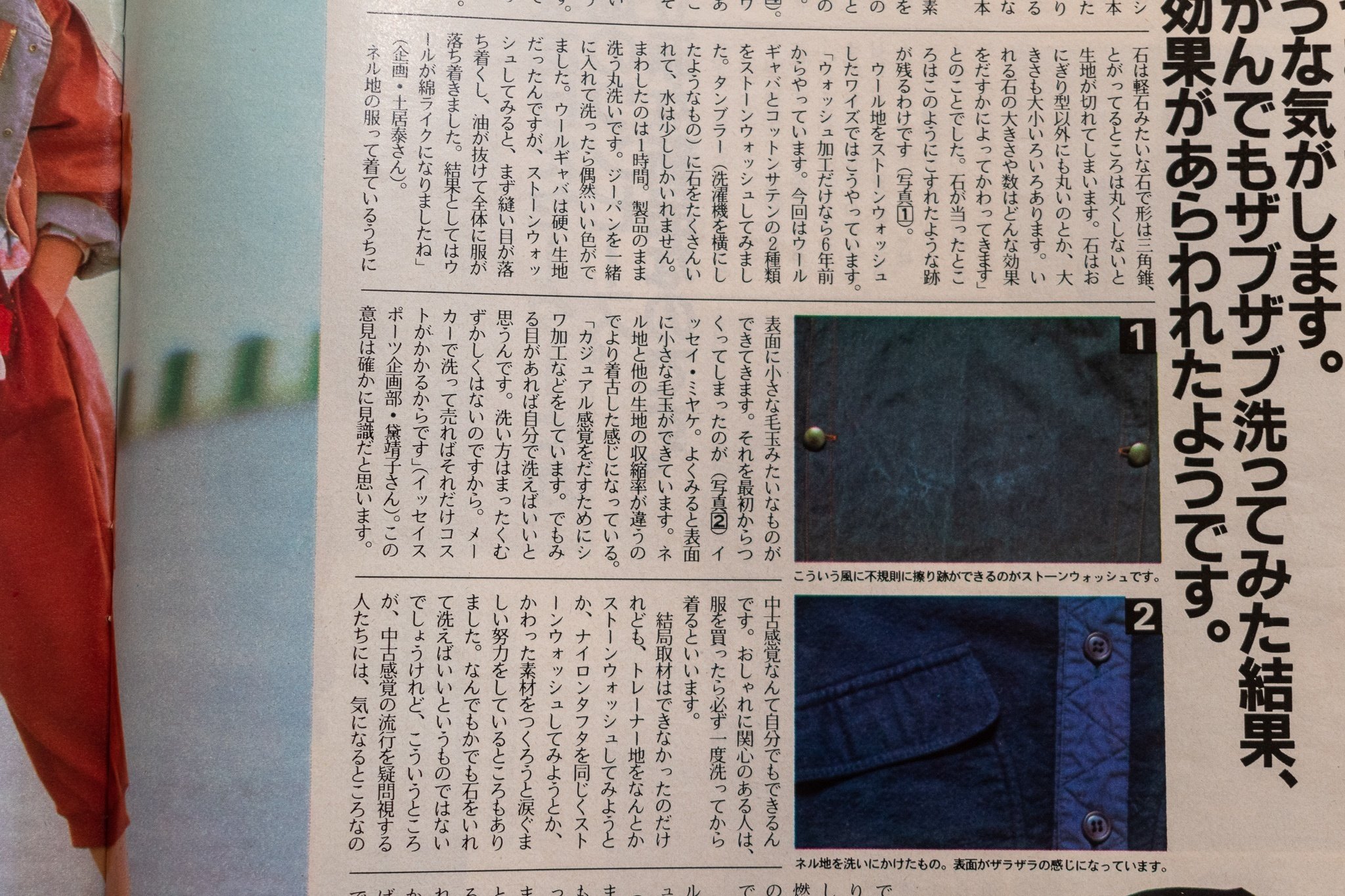
In response to this comment from Issey Miyake, AnAn magazine adds the following:
This opinion is indeed insightful. Creating a used aesthetic is something one can certainly achieve on their own. Fashion-conscious individuals often say that after buying clothes, it's essential to wash them once before wearing them.
Predecessor of Felting? Comme des Garçons' Processing Methods
Styling centered around stone-washed items.

On the next page, a processing method opposite to washing is introduced.

"Alongside methods to remove oil, there are also techniques deliberately saturating oil into the fabric. One such method is called paraffin processing."
This excerpt introduces a processing method used in Comme des Garçons.
"We remove the oil at the stage of yarn before weaving it into the fabric. Of course, the material is wool. After weaving it into fabric, we further wash it and let it dry in the sun. At that time, we give it a wrinkle processing. As a result, it feels like cotton material. It's a bit prickly on the skin, but..."
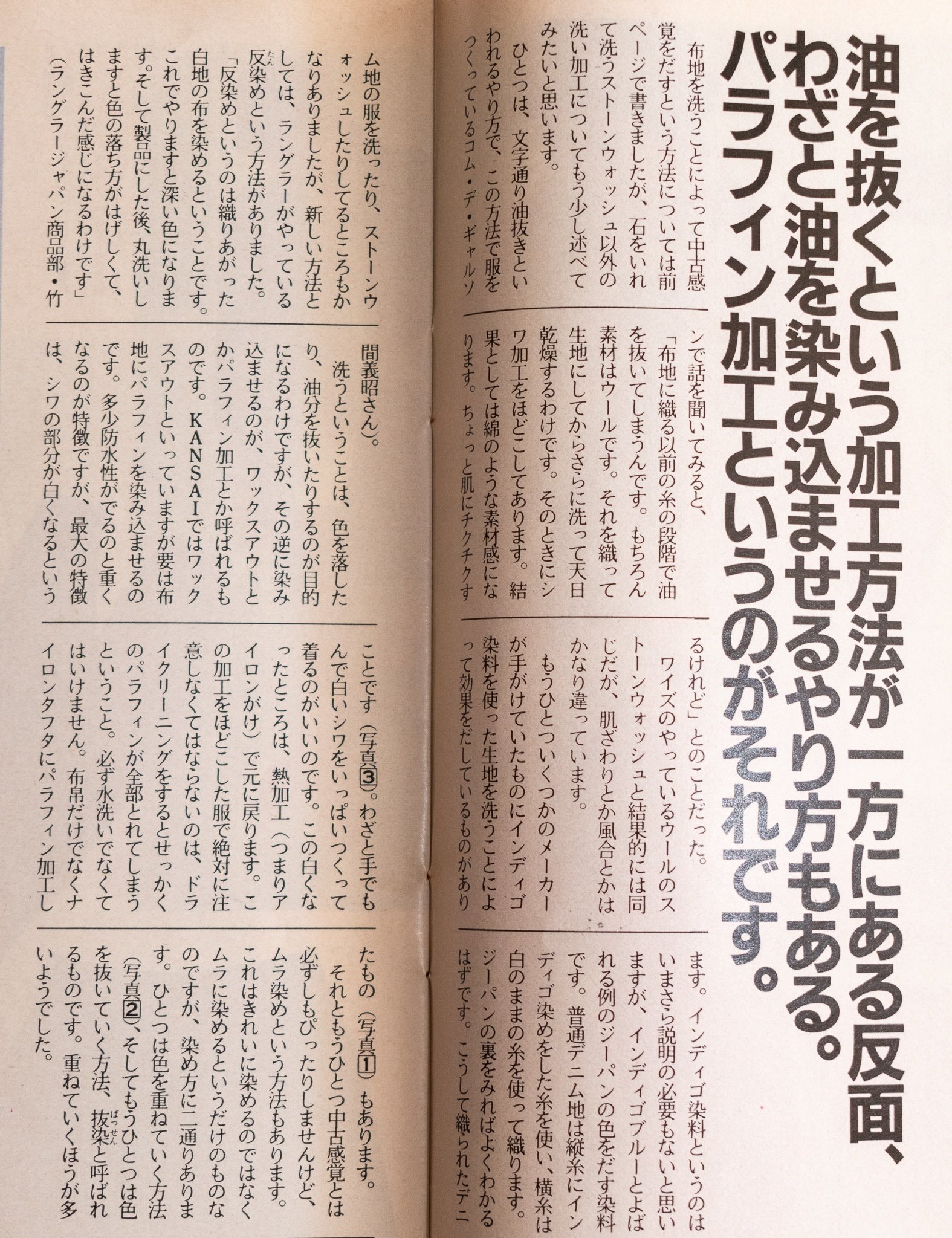
And on this page, the styling features items from Comme des Garçons that have been described as "wool treated to remove oil, then washed with water to give it a cotton-like feel."
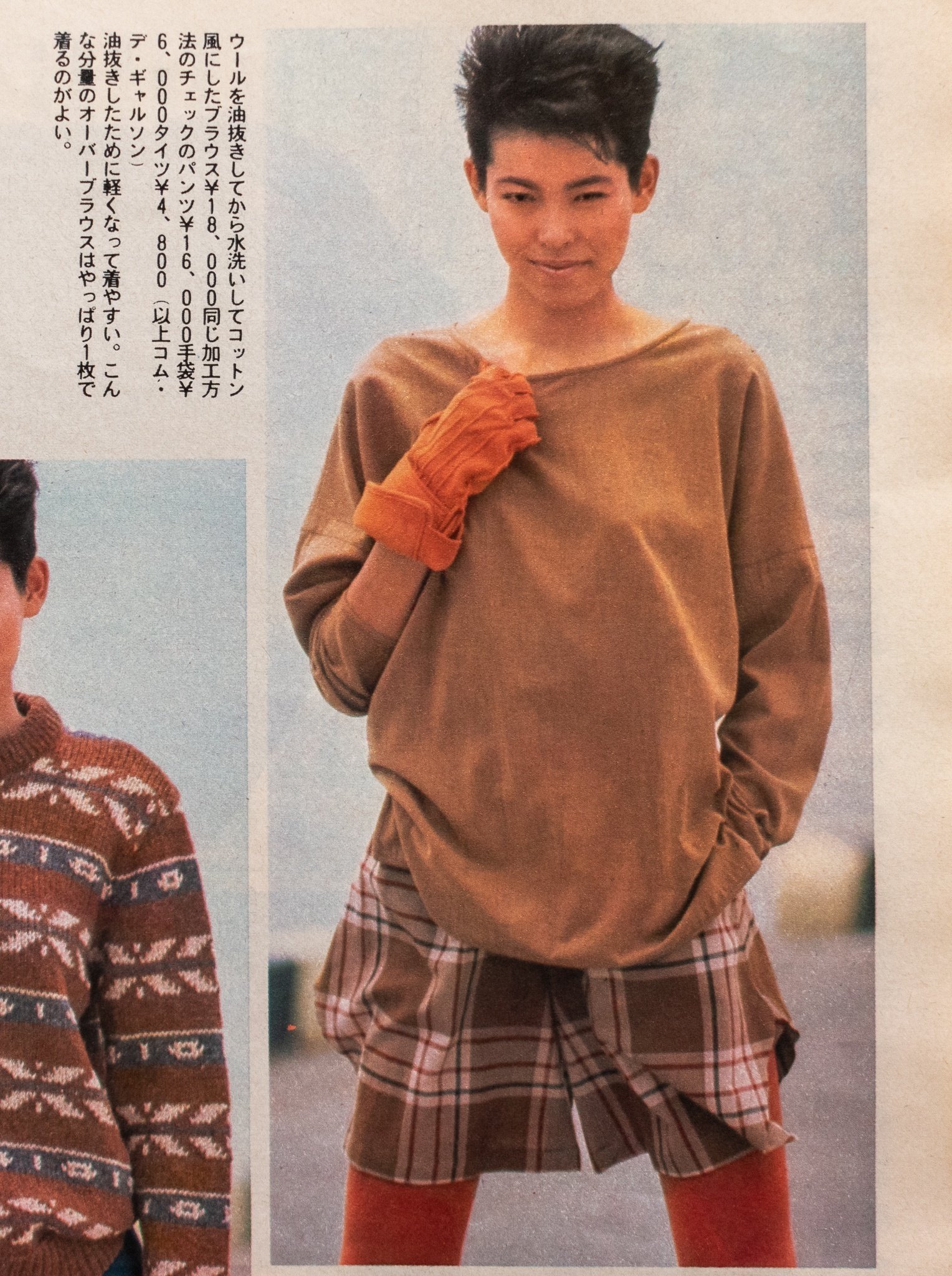
The experimentation with "used" processing by Comme des Garçons in the 1980s may have led to the iconic "felting" technique, which became synonymous with Comme des Garçons by the mid-1990s.
This knitwear is from Comme des Garçons Homme.
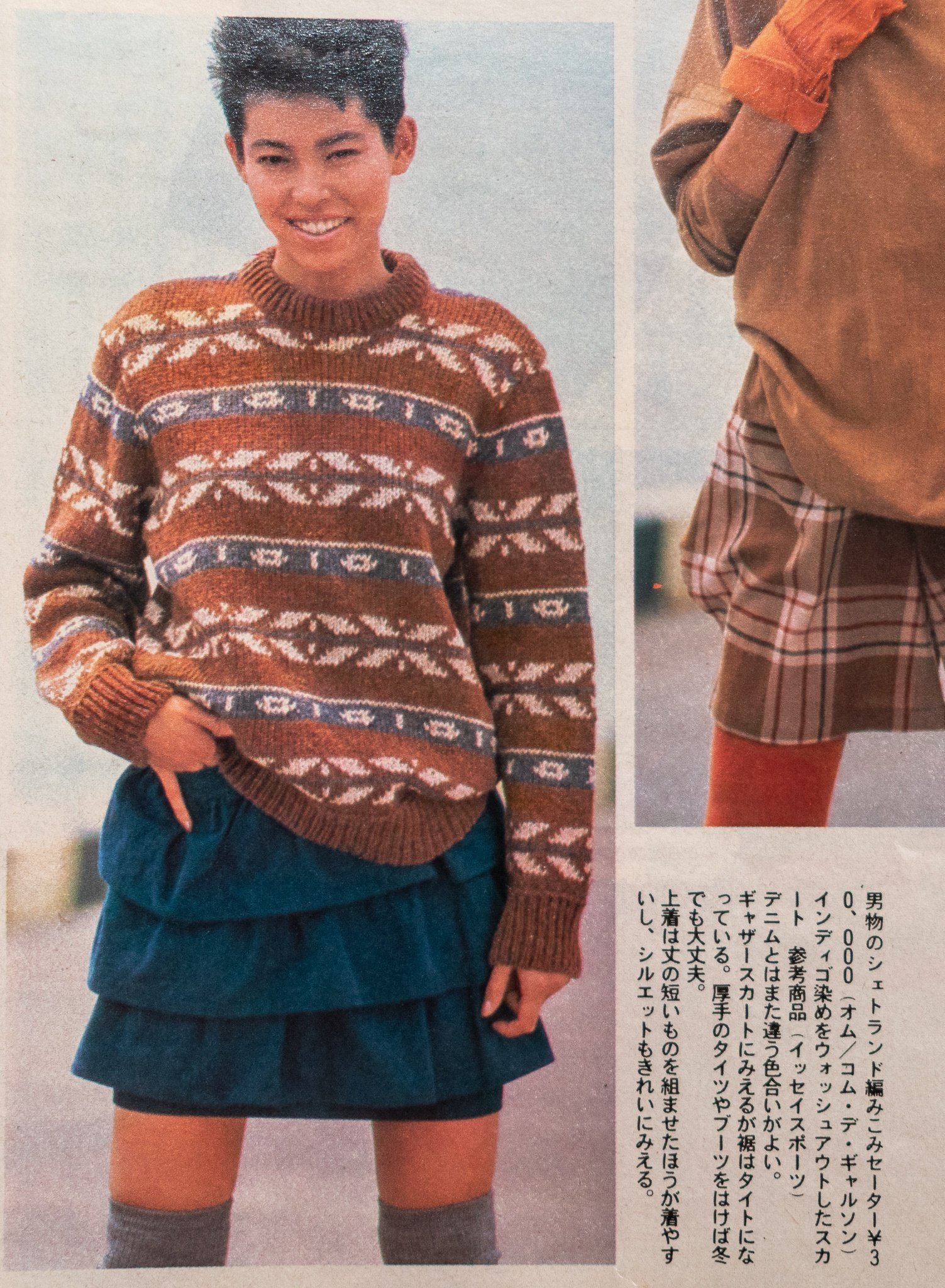
In this very Comme des Garçons-esque styling, they have indeed used Comme des Garçons' "apron dyed with irregularities" in rayon.
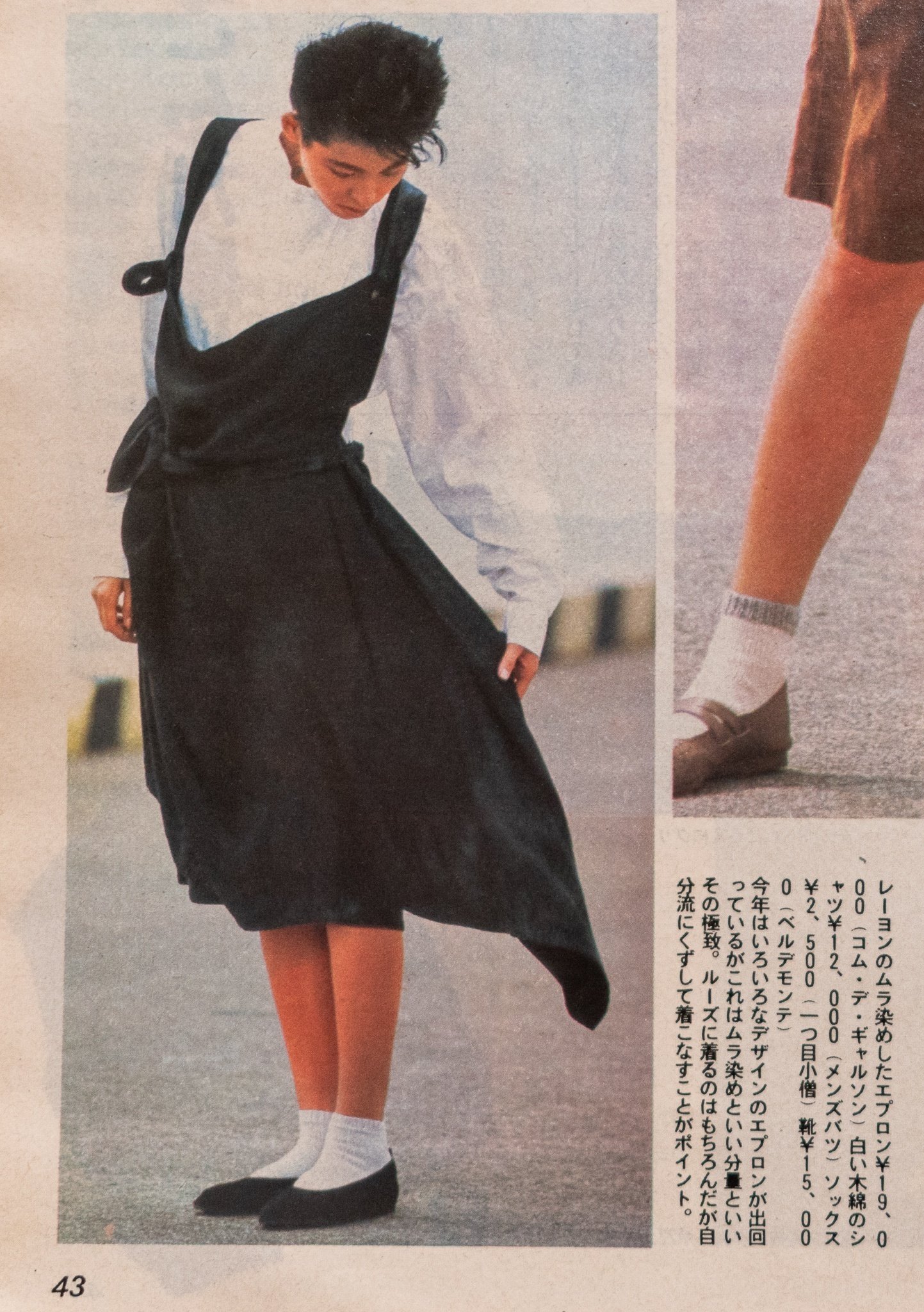
Clothing with a used aesthetic already carries a sense of attachment from the beginning for the wearer.
The final page of this feature.
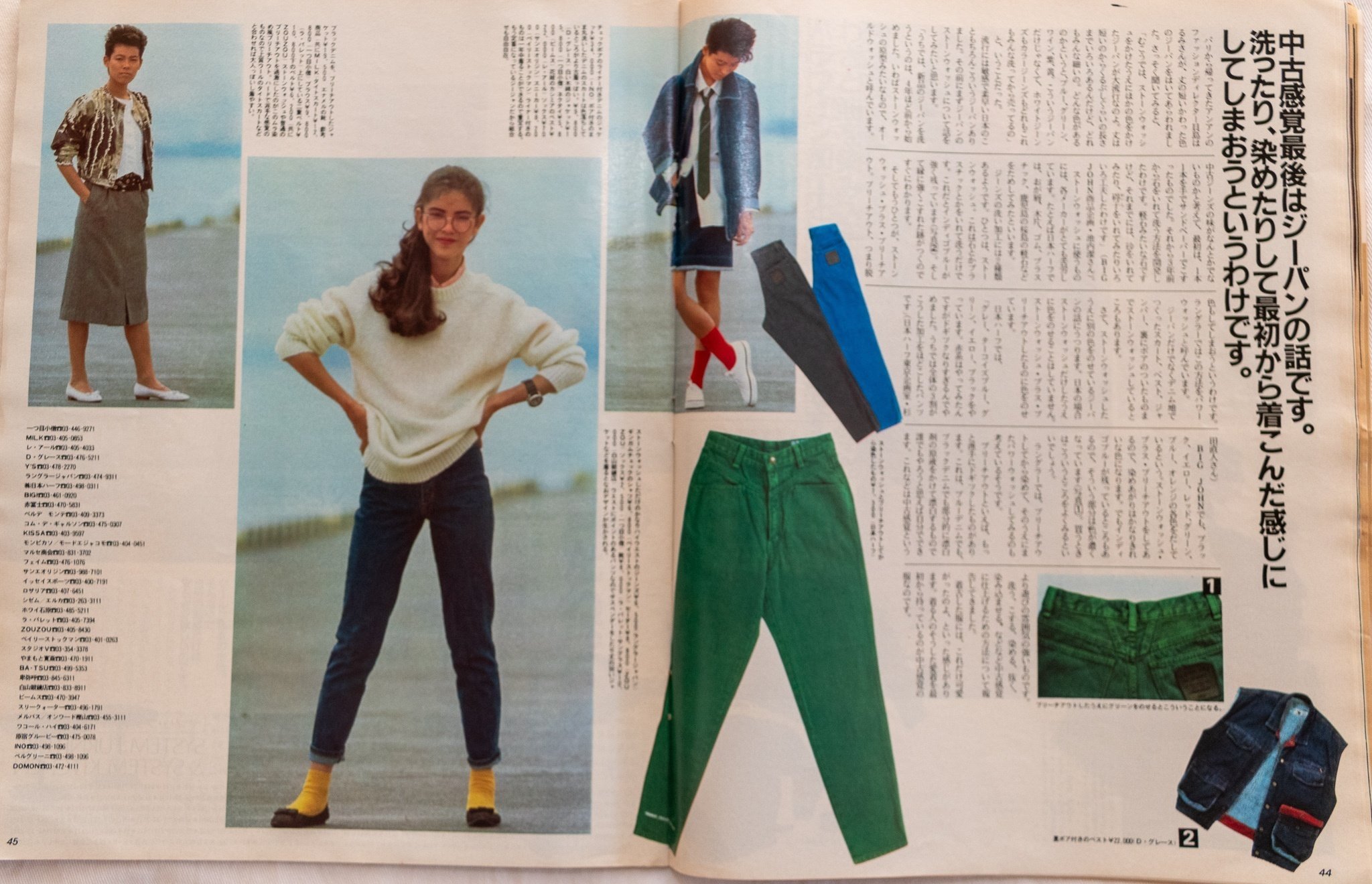
At the end of the 'used aesthetic' feature is a discussion about jeans. The idea is to give them a worn-in feel from the start by washing or dyeing them. This section introduces processing methods used by denim manufacturers like Big John and former companies like Japan Half.
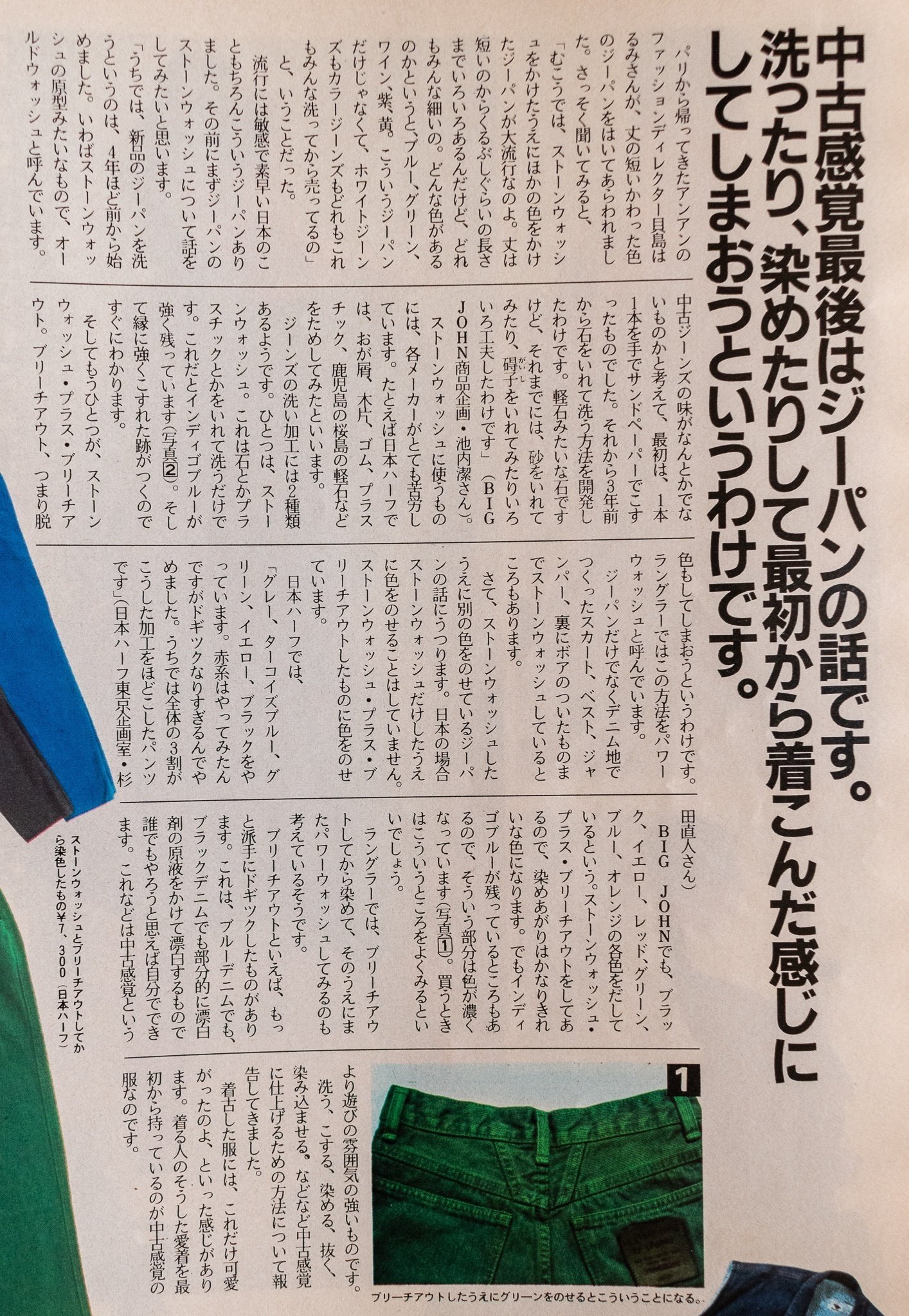
A variety of denim items featuring processing such as stone wash, bleach out, power wash, and more.
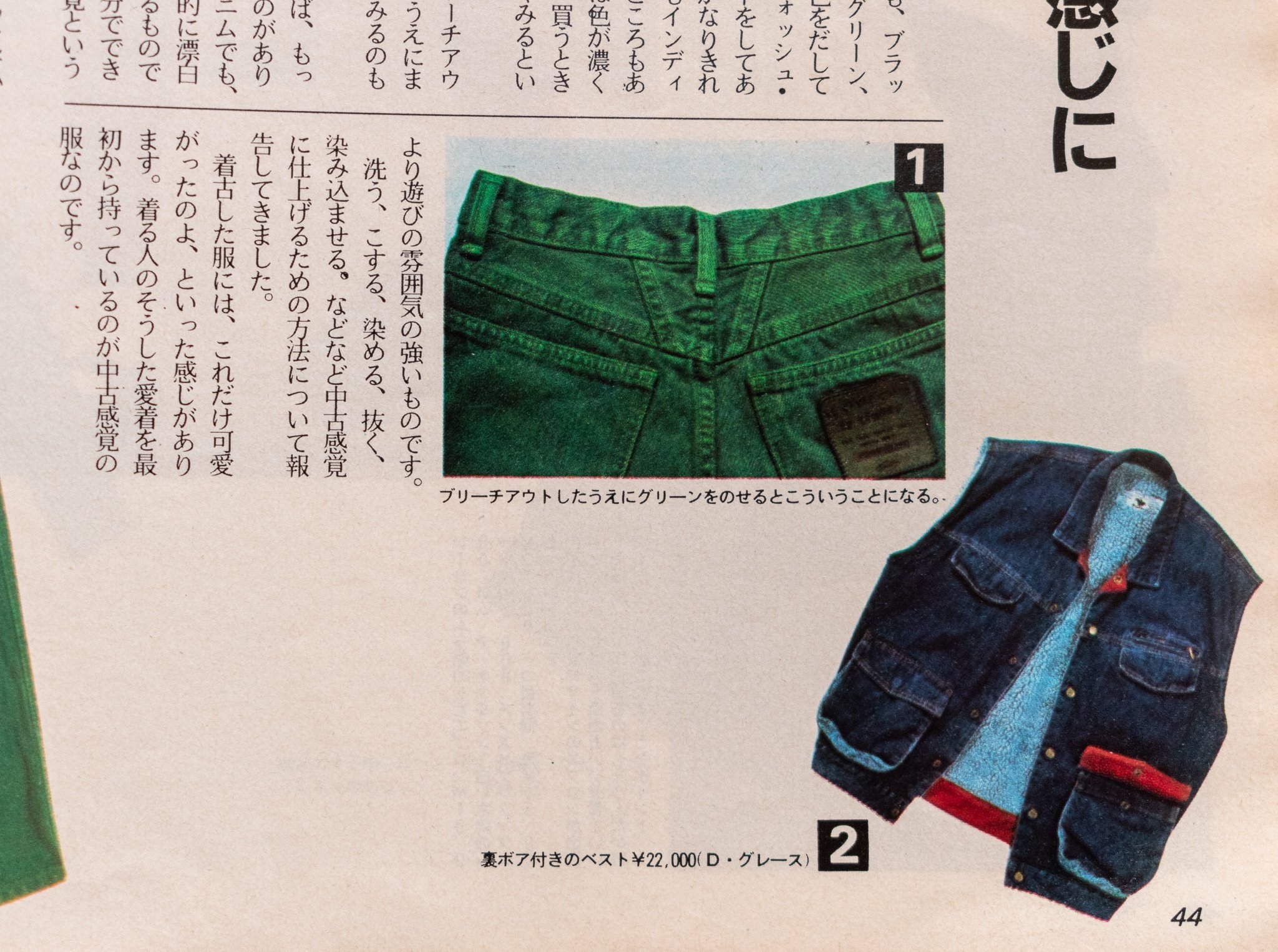
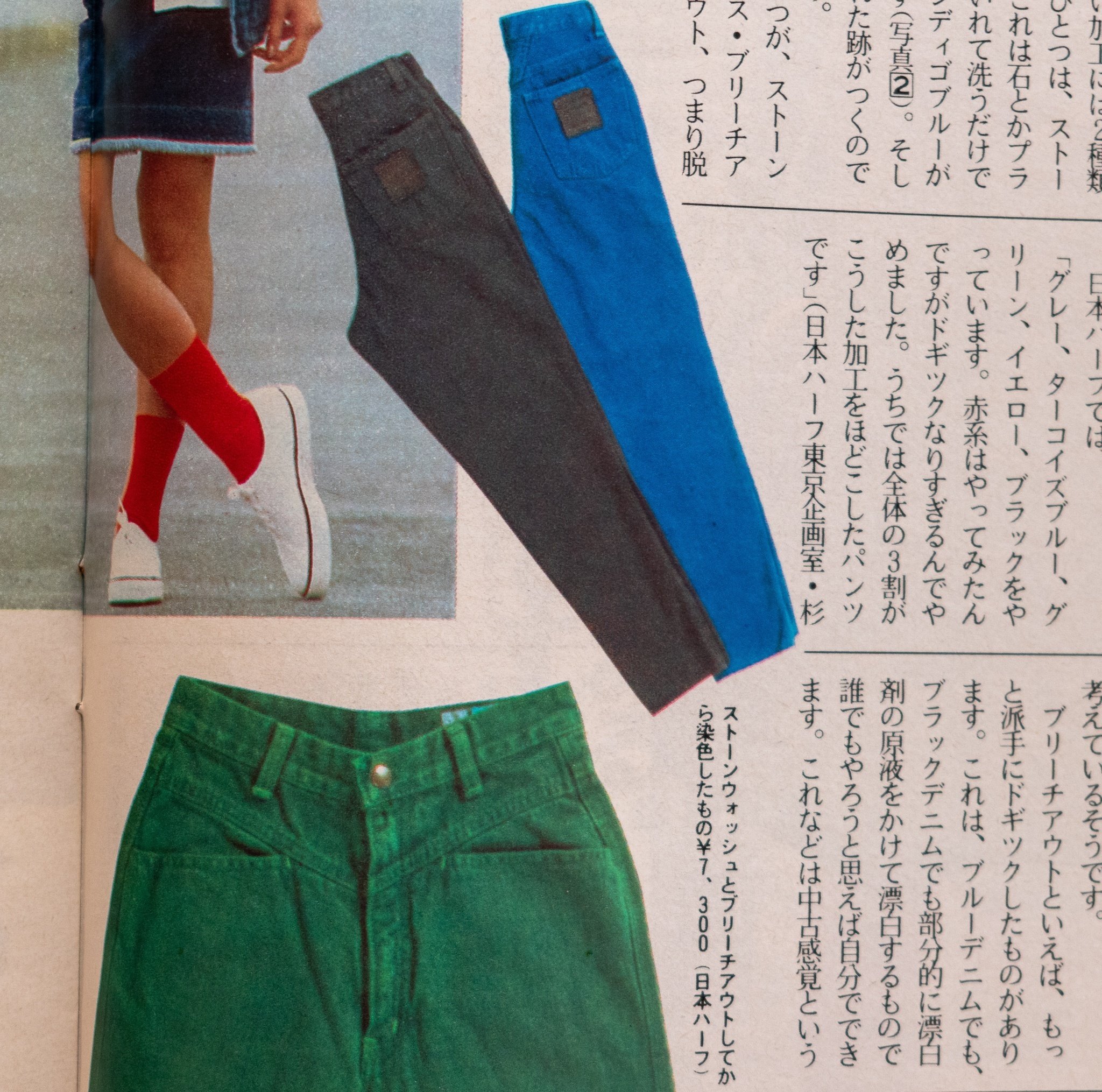
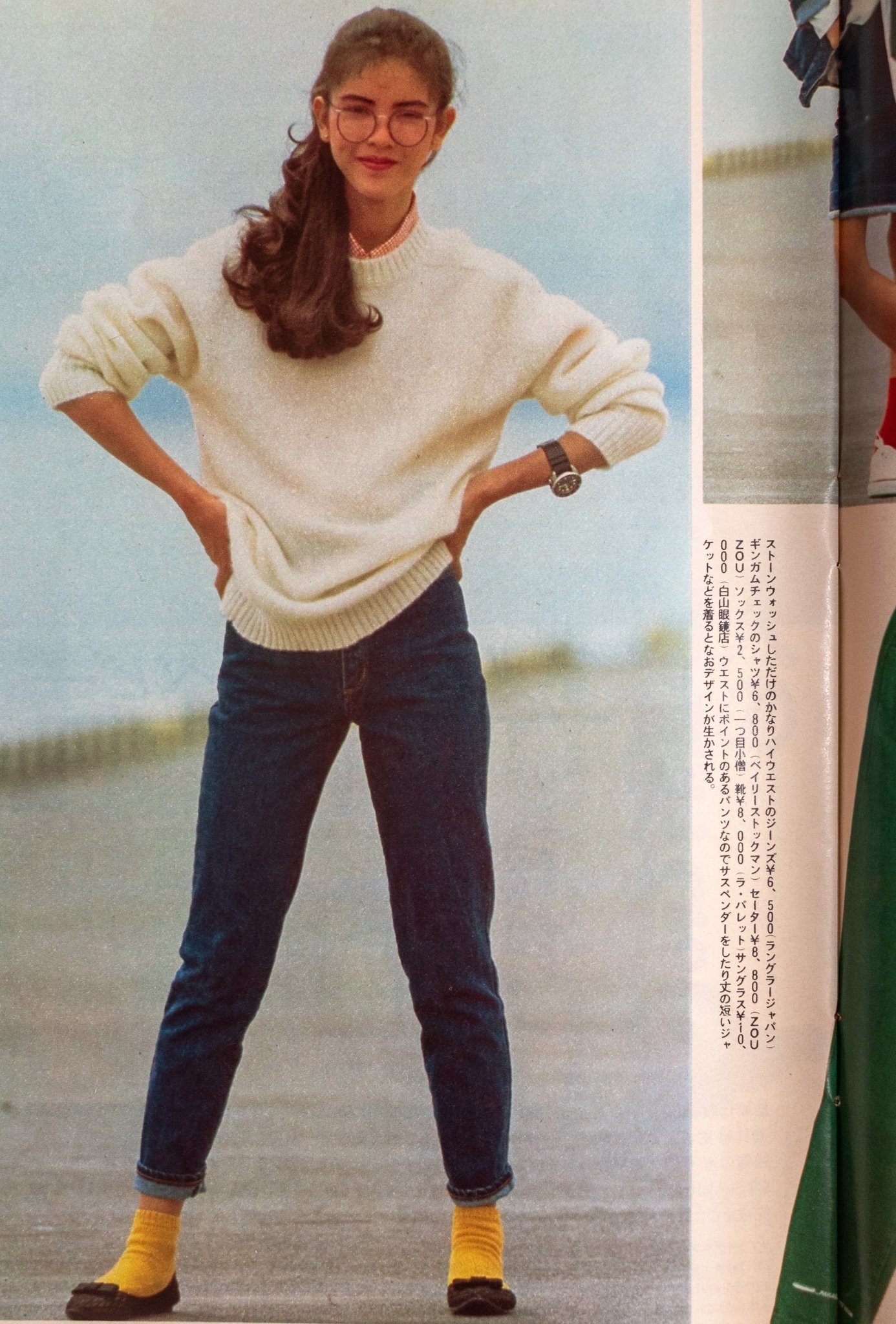

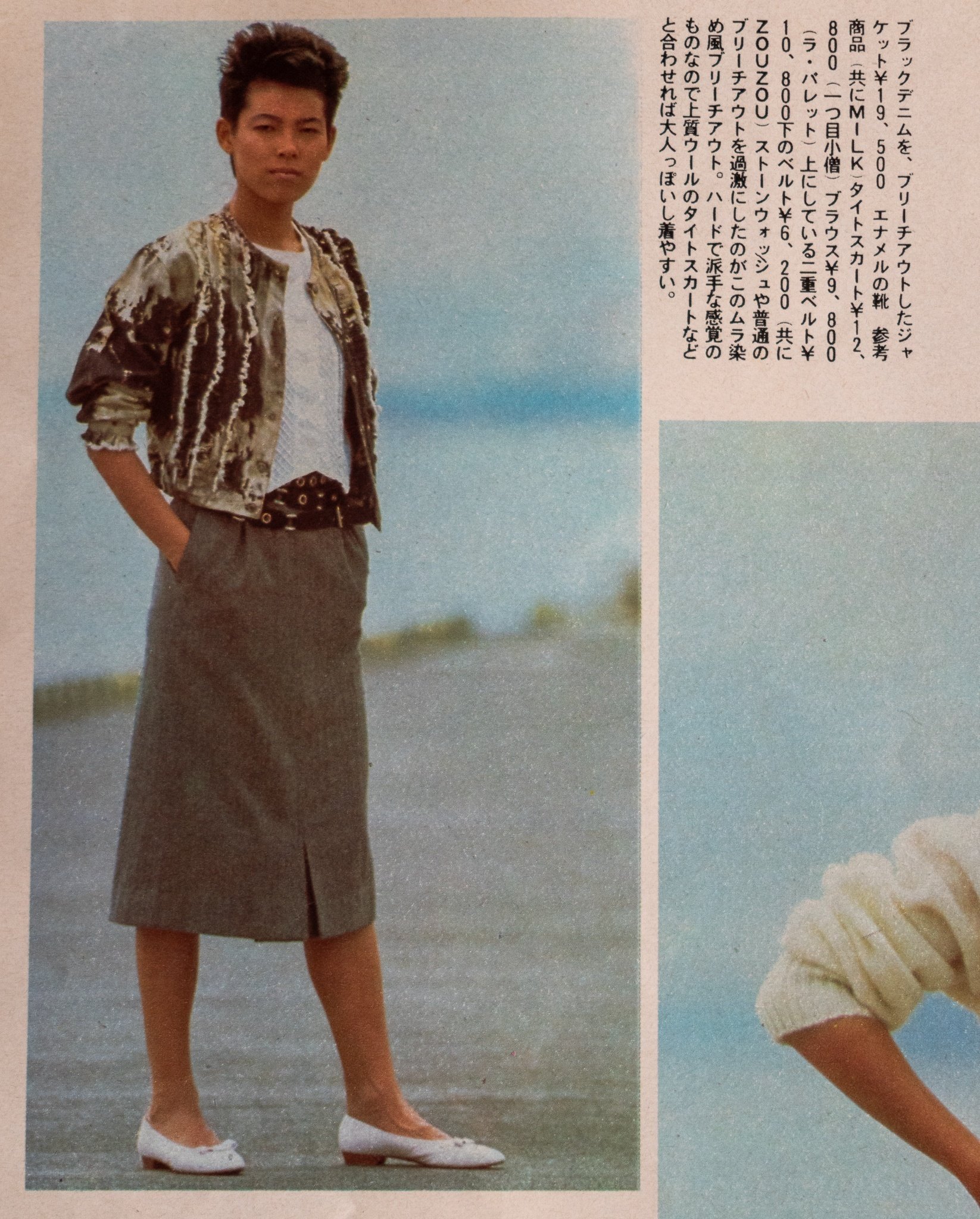
And at the end of the feature, the closing statement reads as follows:
There's a feeling of "I've cherished this worn-out clothing so much," as if it already carries the wearer's affection from the beginning. That's the essence of secondhand clothing—it embodies the wearer's attachment right from the start.

Outro: "Japan as Number One" and "Japanese Designers as Number One"
At the beginning of this article, we introduced the economic trends since the end of World War II. In the early 1980s when the September 10, 1982 issue of AnAn was released, Japan was the world's second-largest economy. Although the era of high economic growth had ended, Japan's economy was still on the rise, earning it the nickname "Japan as Number One" and posing a threat to the world's largest country, the United States. Economic conditions have a significant impact on consumer attitudes and behaviors.
In the early 1980s, the performance of supermarkets, representing mass consumption, deteriorated rapidly. Toshifumi Suzuki, Chairman of Seven & i Holdings, analyzed it as "an era where goods don't sell due to oversupply. Consumer behavior changed significantly, shifting from a seller's market to a buyer's market."
Then came the 35th anniversary of the opening of Tokyo Disneyland (TDL). There was also a significant change in the annual "Public Opinion Survey on National Life" conducted by the government. For the first time in the fixed-point survey's question "What will be the focus of your life in the future," "leisure and recreation" surpassed "living environment" to take the top spot. Since then, its position has remained unshakeable. It was a moment when the perception of prosperity shifted from goods to services.
"Postwar Economic History of Japan (Nikkei Bunko)"
A symbol of consumption in the 1980s would undoubtedly be the opening of Tokyo Disneyland in 1983.
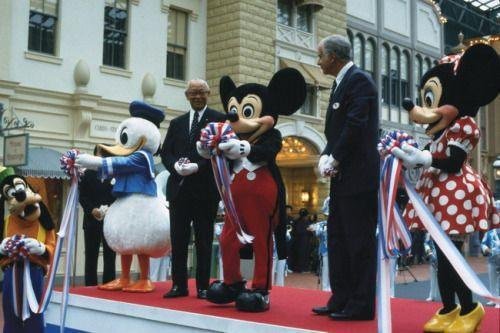 https://www.pinterest.jp/pin/746330969487063862/
https://www.pinterest.jp/pin/746330969487063862/
Similarly, fashion in the 1980s began to evolve from being perceived solely as a necessity of life, like clothing under the category of clothing, food, and shelter, to embracing new values such as the "used feeling" introduced in this article. This era saw the emergence of new perspectives.
With brands like Comme des Garçons and Yohji Yamamoto venturing into the Paris collections, albeit with mixed reviews, they gained international recognition. This renewed attention also extended to designers like Kenzo and Issey Miyake, who had been presenting collections in Paris and New York since the 1970s.
The recognition of Japanese fashion on the global stage became a source of immense pride for the Japanese people, akin to the pride associated with Japanese automobiles as representatives of "Japan as Number One".
From this backdrop emerged the fashion phenomenon known as the "Crow Tribe".
By 1983, fervent followers of Yamamoto and Kawakubo were striding through Tokyo and Osaka from head to toe clad in the designs of these two visionaries. They layered long, jet-black garments, cut their hair asymmetrically, wore deliberately natural makeup on their faces, and donned flat shoes. The media promptly dubbed these women the "Karasu-zoku"(Crow Tribe).
The emergence of the "Karasu-zoku" owes much to the presence of the weekly magazine *AnAn*, which was serialized in the 1980s. Since its inception in the 1970s, the magazine had wielded immense influence as a fashion guide for young women. However, from the late 1970s, it began primarily featuring various DC brands that originated from condominium developers.
"Street Fashion 1980-2020: A 40-Year Record of Observing Fixed Points"
The foundation for the emergence of the "Karasu-zoku" was laid by the New Wave music genre, which originated and spread in London and New York in the 1970s. This genre was characterized by its decadent and avant-garde nature, and it gave rise to New Wave style in street fashion.
The first to adopt this style in Japan were students from art-related fields, musicians, and their aspiring followers. Subsequently, it permeated as the fashion of the "Tongari Kids," a cultural group enthralled by avant-garde and mannered new music genres such as New Wave, Punk, and Techno.
"Street Fashion 1980-2020: A 40-Year Record of Observing Fixed Points"
The "Tongari Kids" favored emerging designer brands of the new generation like Comme des Garçons and Milk, which were initially referred to as "mansion makers" and started from a room in an apartment building in Harajuku.
At that time, domestic brands that operated their own stores with consistent characters but without putting the designer in the forefront were distinguished as character brands, as opposed to designer brands. Both were collectively referred to as DC brands. Character brands included names like Comme ça du mode, Parsons, and Atelier Sab, offering more affordable prices compared to designer brands.
The major difference between mainstream apparel and designer brands up to that point lay in their clothing production systems. While mainstream apparel companies operated a complex system involving around 20 transactions from fabric sourcing to the final product, designer brands managed everything from fabric procurement to sales in their own stores. Each directly operated store featured an interior design that unmistakably represented the brand, using brand-original elements down to the hangers. Mannequins clad in the brand's clothing handled customer interactions, giving the impression that simply being in the store was cool. As customers frequented the store, they became familiar with the mannequins, feeling as if they were friends and gradually becoming followers of the brand. In fact, it was nearly impossible to acquire popular items showcased in fashion shows without being on friendly terms with the mannequins.
Born from this trend was the DC brand boom, representing the fashion movement of the 1980s. While the DC brand boom was a domestic phenomenon in Japan, the impact of designers like Comme des Garçons and Yohji Yamamoto resonated strongly with fashion designers who would later thrive overseas.
Many fashion designers who emerged in the 1990s and beyond, such as Martin Margiela from Antwerp Royal Academy of Fine Arts and Alexander McQueen from Central Saint Martins, were deeply influenced by Comme des Garçons and Yohji Yamamoto.
The book "Japan as Number One" argued that American companies should learn from the thriving Japanese automobile and semiconductor industries. Similarly, Comme des Garçons and Yohji Yamamoto, if not more so, had a profound impact on the global fashion scene.
The 1980s were not only the era of "Japan as Number One" but also the era of "Japanese Designers as Number One." (End)